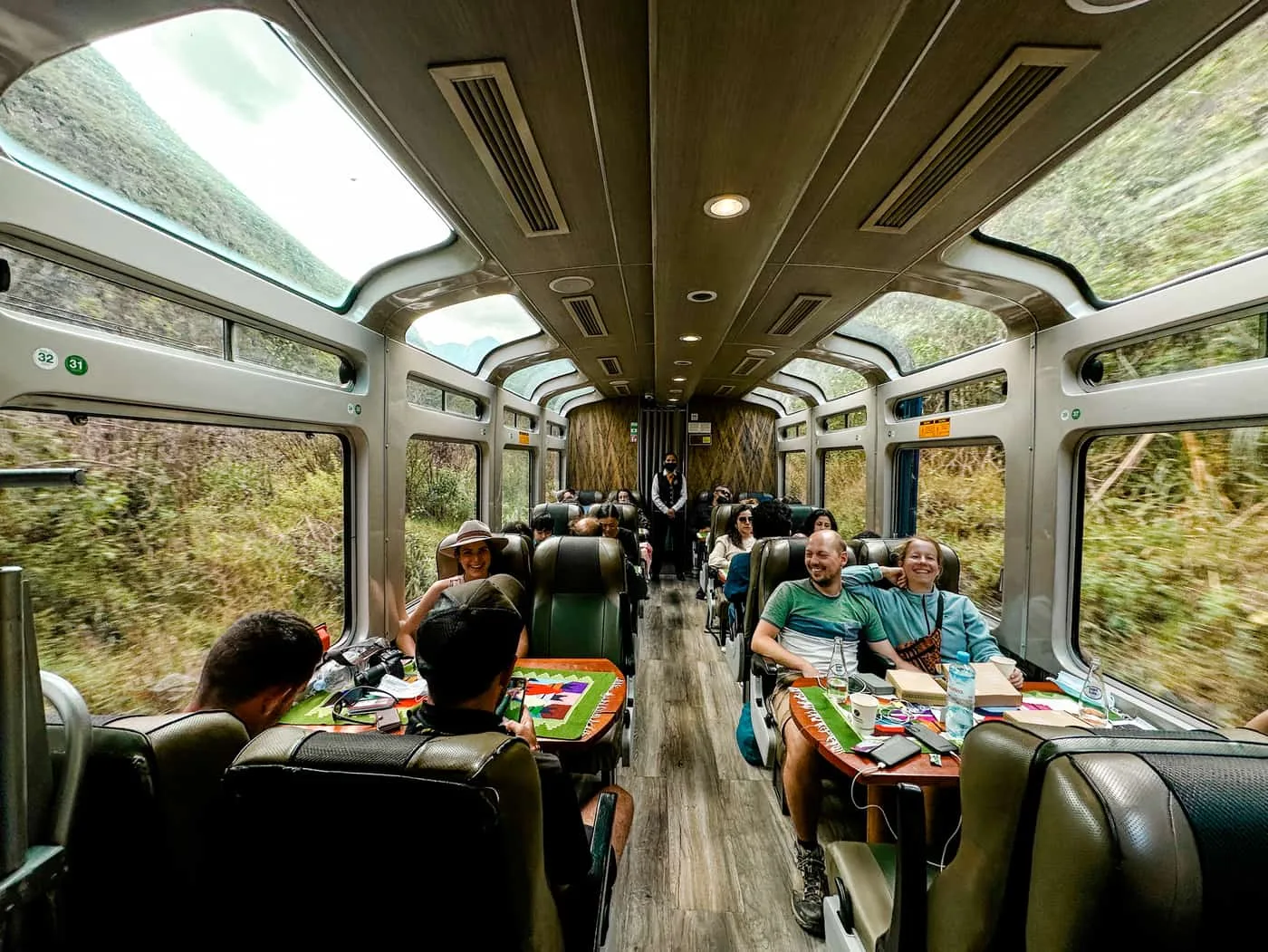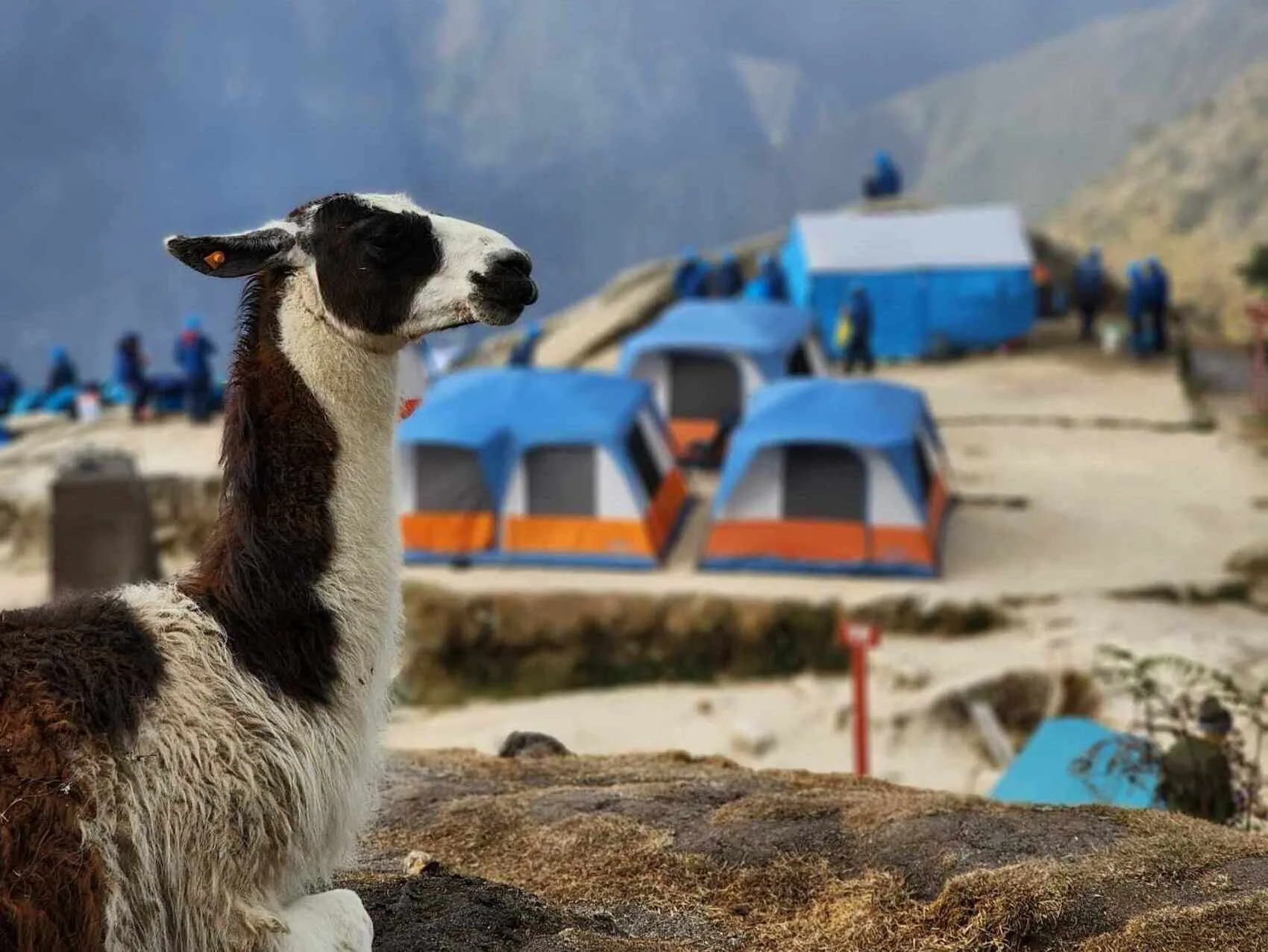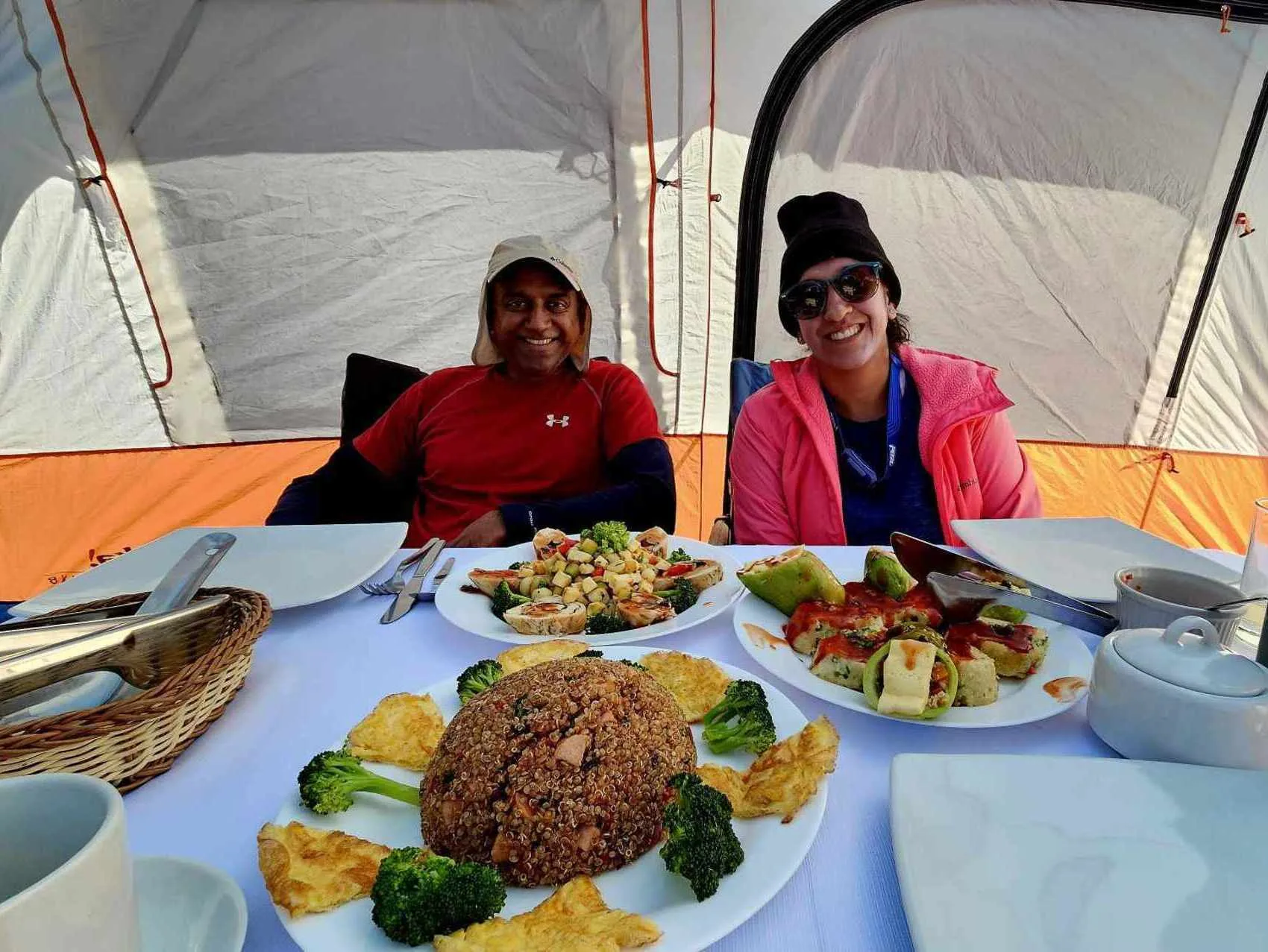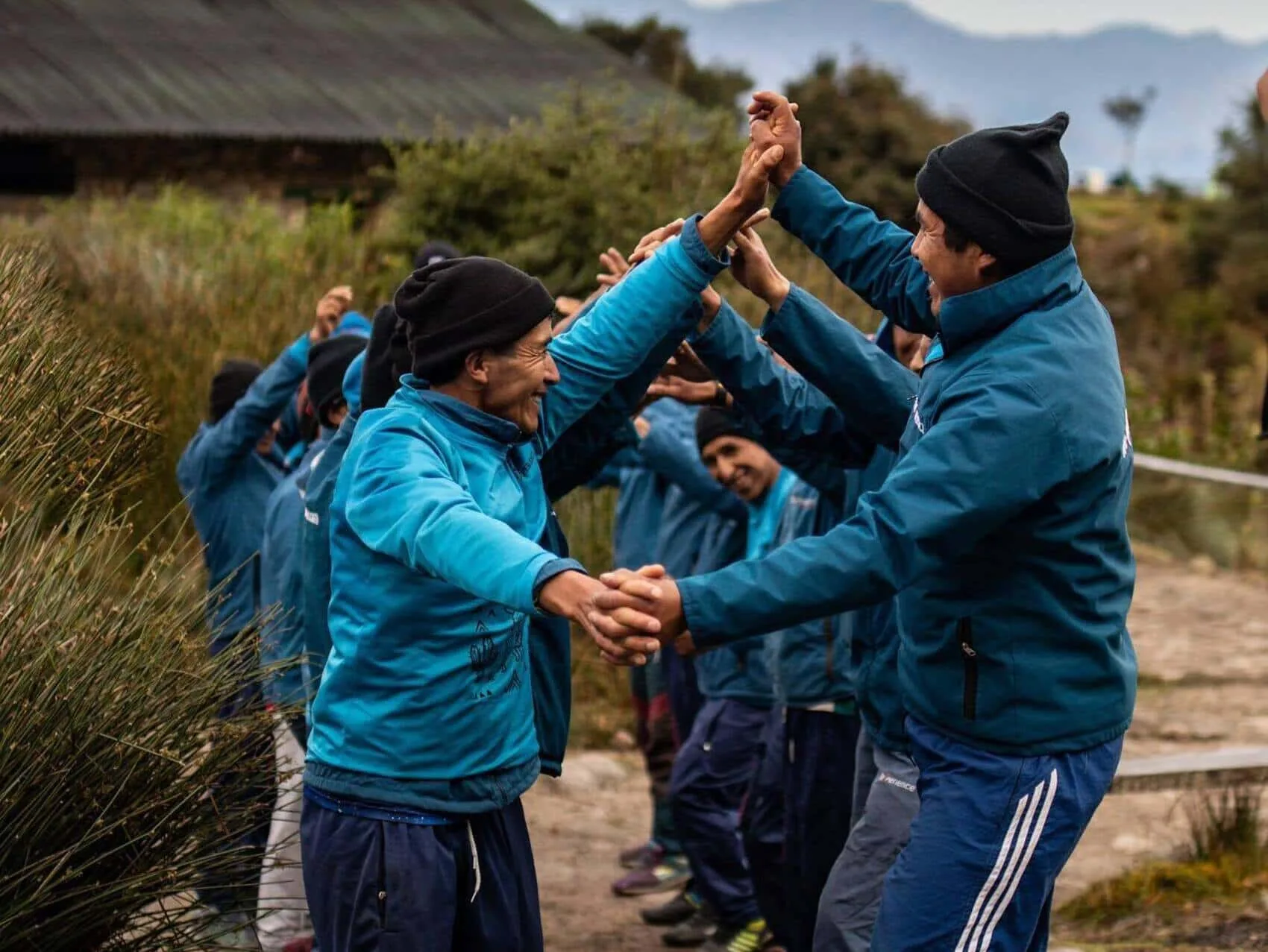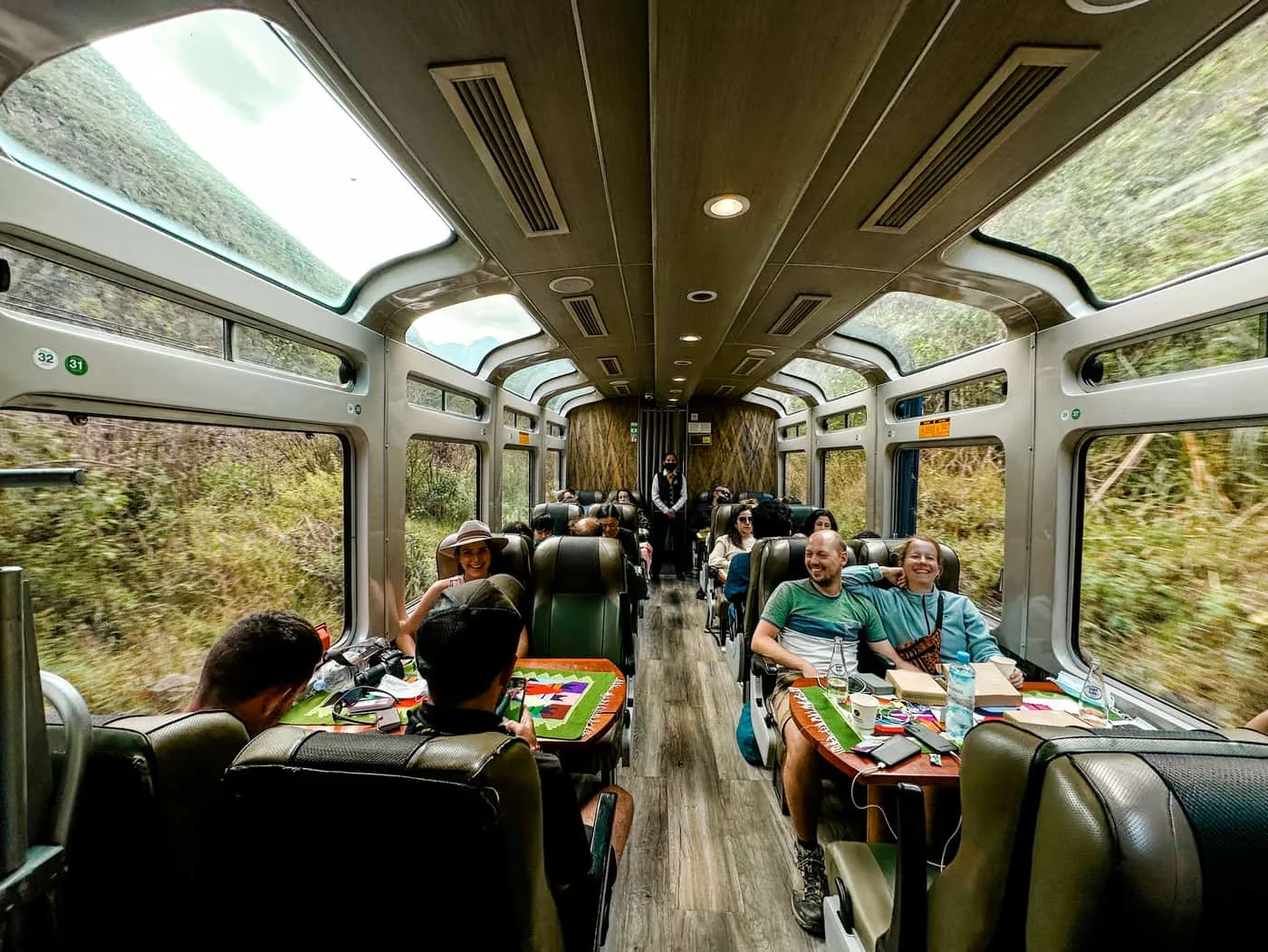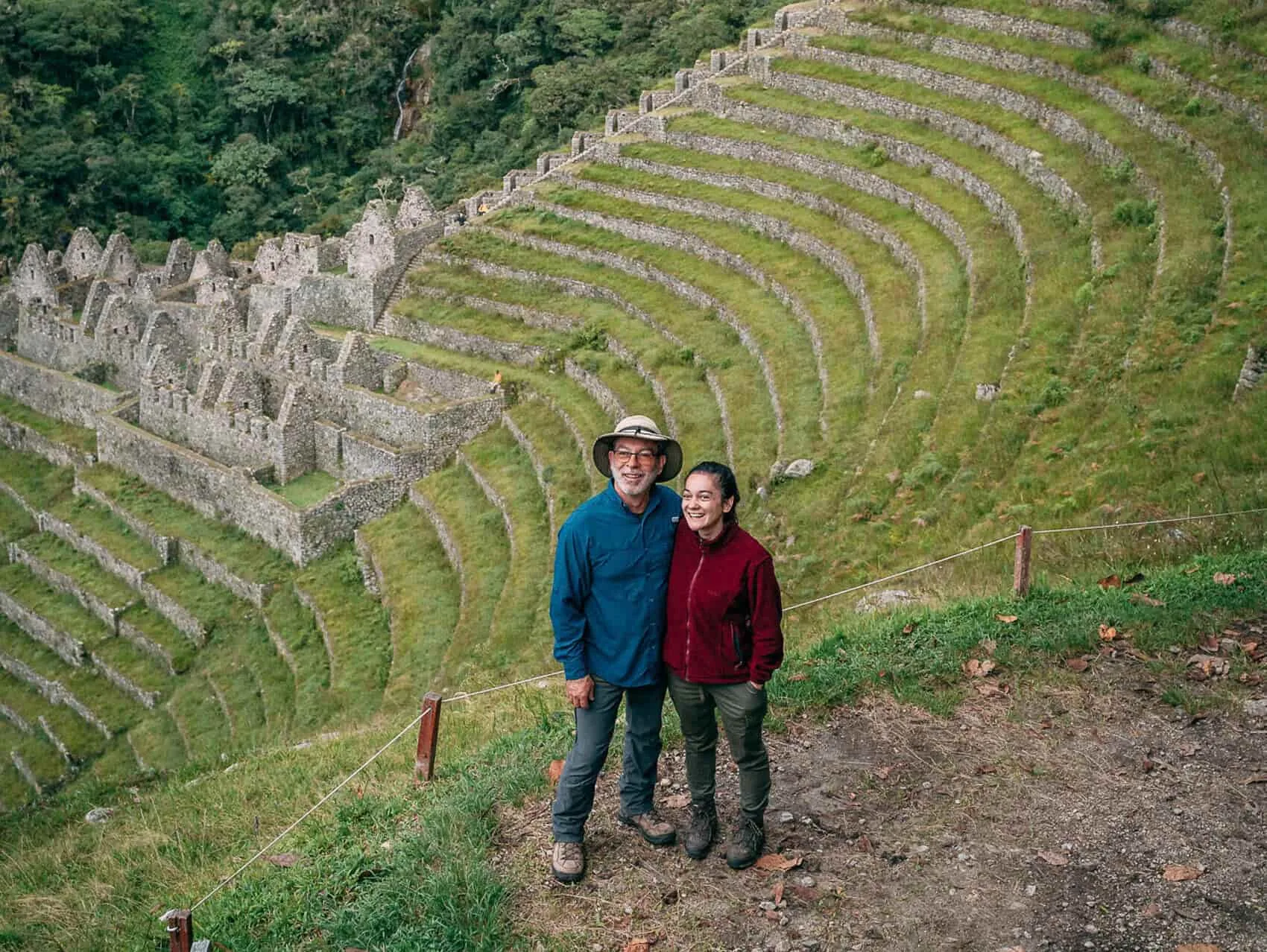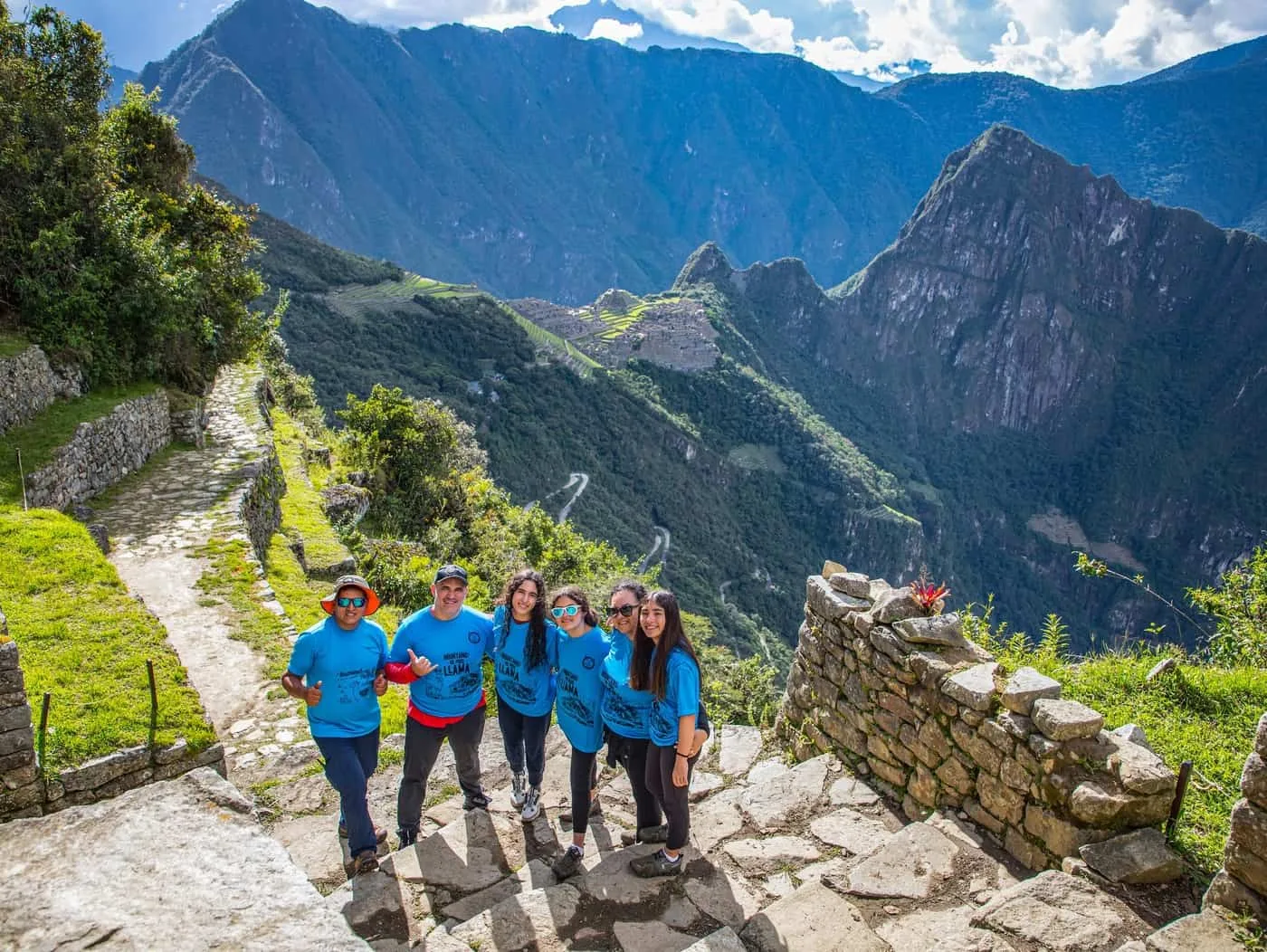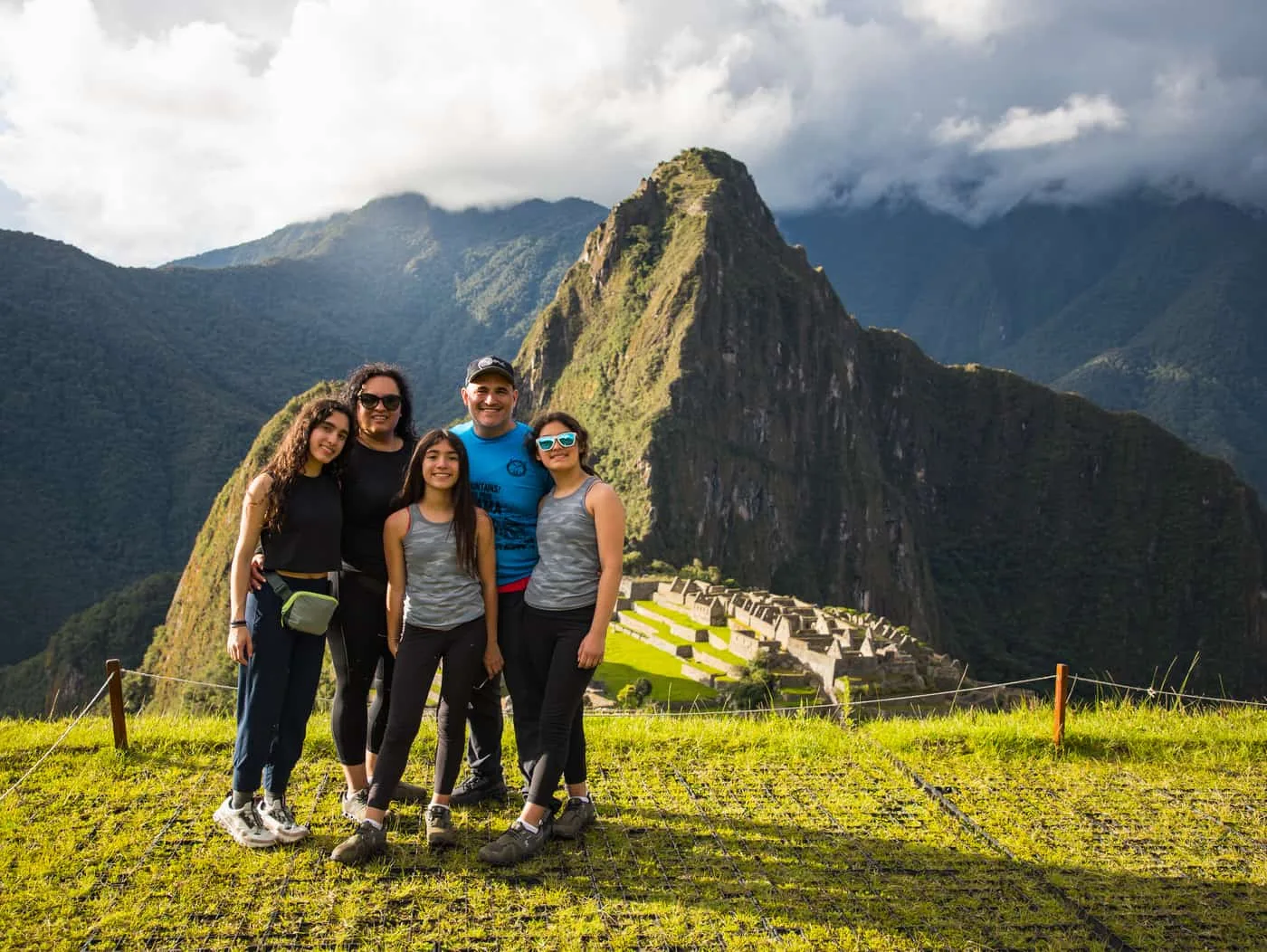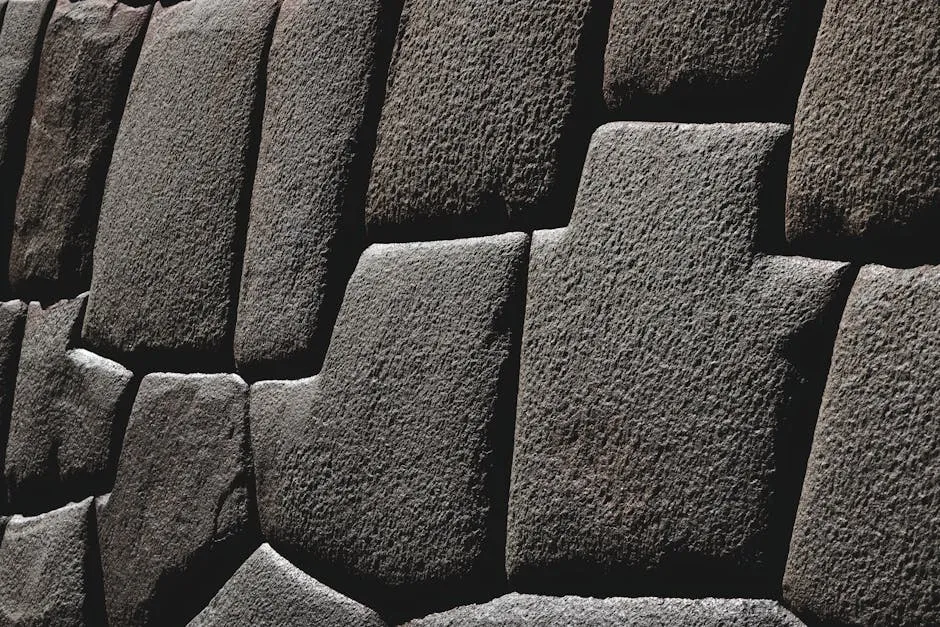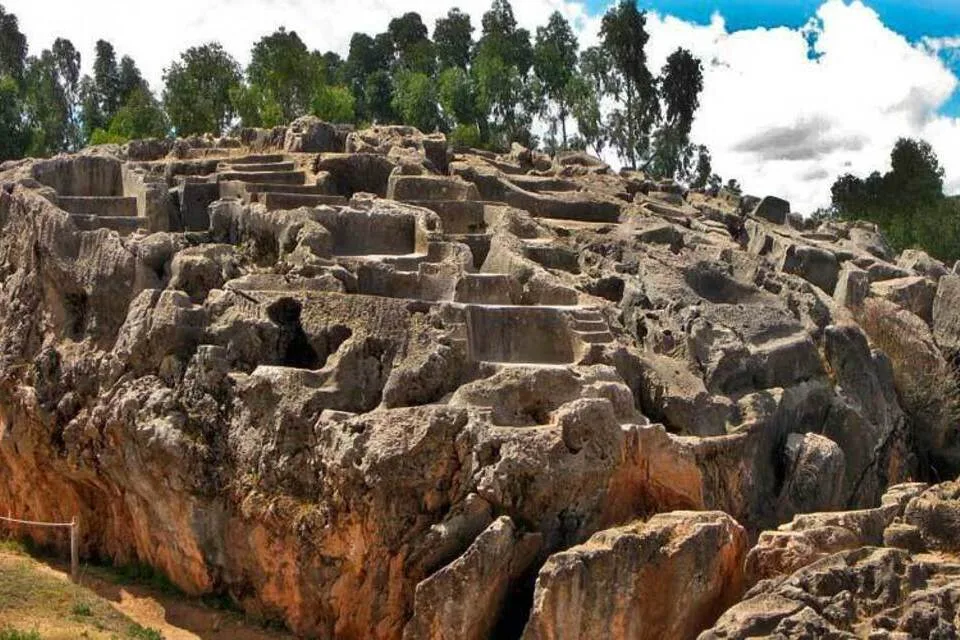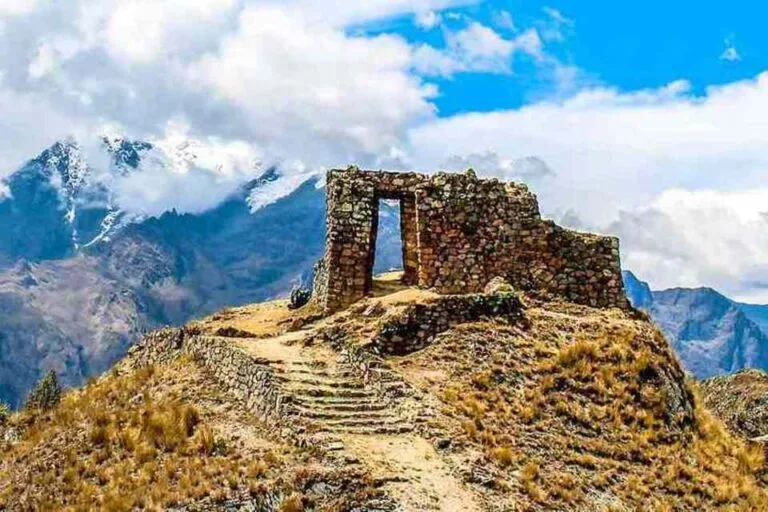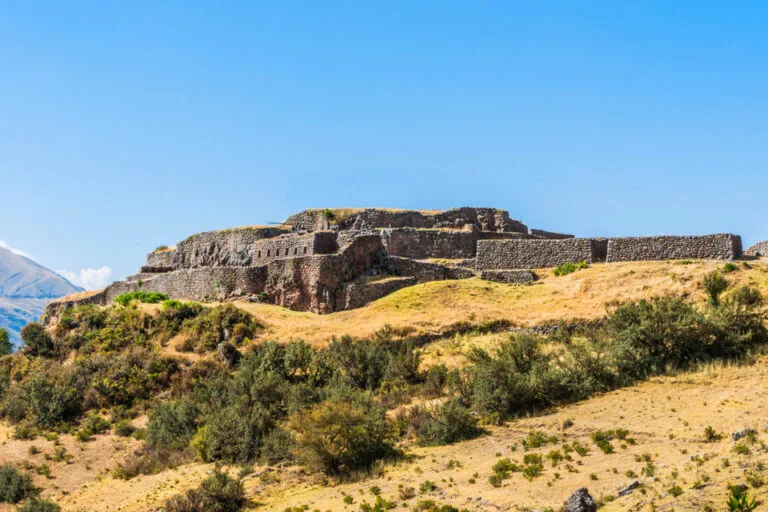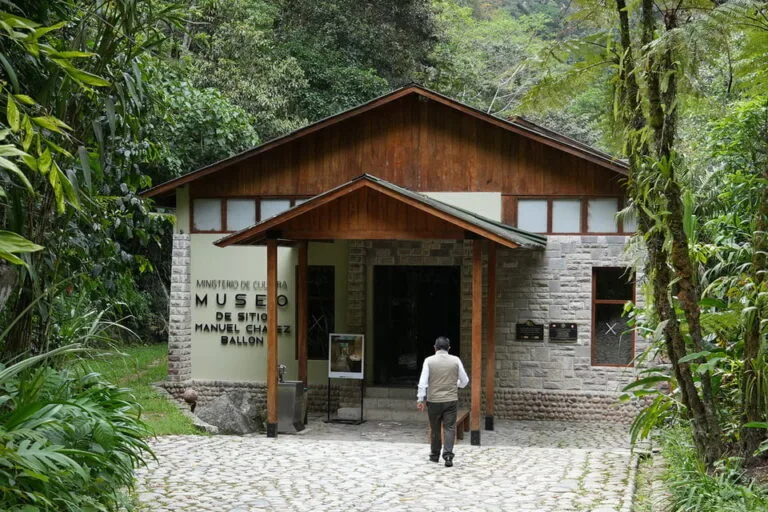The legendary Inca Trail to Machu Picchu
The Inca Trail to Machu Picchu is one of the most famous trekking trails in the world. This ancient route, built by the Incas hundreds of years ago, attracts people from all over the world seeking a unique experience surrounded by nature and history. Along the 42-kilometer hike, travelers not only face a physical challenge but also have the opportunity to connect with the history, culture, and beauty of the Peruvian Andes.
The Inca Trail to Machu Picchu: A Unique Journey Through the Andes
The Inca Trail is much more than just a hiking route. It is a testament to the skill and creativity of the Incas, a civilization that ruled much of South America before the arrival of the Spanish. This trail was part of a vast network of roads that connected the entire Inca Empire, which covered areas of modern-day Peru, Ecuador, Bolivia, Argentina, and Chile.
Why Was This Trail Built?: The Incas didn’t build the Inca Trail just to travel from one place to another. This route had a special purpose: it was a sacred path used for religious pilgrimages and ceremonies. Machu Picchu, known as the “Lost City of the Incas,” was a significant site both spiritually and politically. The trails leading to this place were designed to reflect its importance, allowing not only access but also the performance of sacred rituals in honor of their gods, such as the sun and the moon.
How Was This Trail Built?: The construction of the Inca Trail showcases the impressive engineering skills of the Incas. Despite the mountainous and challenging terrain, the Incas managed to carve stone steps, build bridges over ravines, and excavate tunnels into the rocks. Walking this trail is like traveling back in time, experiencing the technical expertise that made this feat possible.
Preparation for the Inca Trail
Walking the Inca Trail is not something that should be done without preparation. It’s important to be ready both physically and mentally.
Physical Preparation: You don’t need to be a professional athlete to hike the Inca Trail, but being in good physical condition is essential. It is recommended to train with regular hikes and exercises that strengthen your heart and lungs. Additionally, acclimatizing to the altitude is key. Cusco, at 3,400 meters above sea level, is a great place to get used to the altitude before starting the trail.
Permits and Regulations: Access to the Inca Trail is controlled by the Peruvian government to protect and preserve the site. Only a limited number of people are allowed each day (500, including porters and guides), so it is necessary to secure a permit several months in advance, especially during the high season (May to September).
What to Bring and Where to Sleep: Having the right equipment is crucial for a successful hike. You will need comfortable and sturdy hiking boots, waterproof clothing, a proper backpack, and a sleeping bag for cold temperatures. Most organized tours include tents and meals, but it’s important to confirm these details with the company you hire.
Nature
The Inca Trail passes through a region rich in biodiversity, offering hikers the chance to see a wide variety of plants and animals.
Diverse Flora: Along the hike, you will encounter an amazing variety of plants, from colorful orchids to giant ferns. The different climates along the trail allow for a wide range of species, many of which are unique to this region.
Wildlife: The fauna is also very diverse. You might spot anything from tiny hummingbirds to the majestic spectacled bear, an endangered species that lives in the more remote areas of the trail. Llamas and alpacas are also commonly seen grazing along the mountainsides.
Cultural Experience on the Inca Trail
In addition to its natural beauty, the Inca Trail offers a rich cultural experience. Hikers have the opportunity to learn about the customs and traditions of local communities.
Interaction with the Porters: One of the most enriching aspects of the Inca Trail is the opportunity to interact with the porters. These men, many of whom belong to indigenous Quechua communities, are the true heroes of the trail. Porters carry the tents, cooking equipment, and personal belongings of tourists. Despite the challenging conditions, they are always smiling, showing a positive attitude and a deep knowledge of the trail and the surrounding nature.
Exchanging stories with the porters and learning about their daily lives offers an invaluable perspective on the local culture. Many porters consider their work a way to honor their ancestors, walking the same paths that they did centuries ago. It’s also a chance to practice Quechua, the native language, and gain a deeper understanding of local traditions, such as Andean textiles and agricultural practices.
Getting to Know Local Communities: Many of the guides and porters who accompany tourists on the Inca Trail are local Quechua people. This interaction allows you to learn firsthand about life in the Andes and the traditions that have endured for centuries. Porters play a vital role in the Inca Trail experience, and their work helps keep their cultures alive.
Participating in Andean Traditions: Along the trail, hikers can participate in traditional Andean rituals, such as offerings to Pachamama (Mother Earth). These ceremonies are an important part of the local culture and offer a unique spiritual connection to the land and local customs.
Responsible Tourism on the Inca Trail
With the rise in tourism, the Inca Trail faces the challenge of maintaining its preservation. Peruvian authorities have implemented several measures to limit the number of visitors and protect the site, but it is also important for tourists to do their part to preserve this unique place.
Efforts to Protect the Trail: Local and international organizations are working to preserve both the Inca Trail and Machu Picchu. These efforts include repairing sections of the trail, implementing waste management policies, and educating visitors on the importance of conservation.
Practicing Responsible Tourism: Responsible tourism is essential for the future of the Inca Trail. This includes supporting local communities, choosing tour operators that respect the environment and local cultures, and being mindful of the impact of our actions as visitors.
Classic Inca Trail
Summary
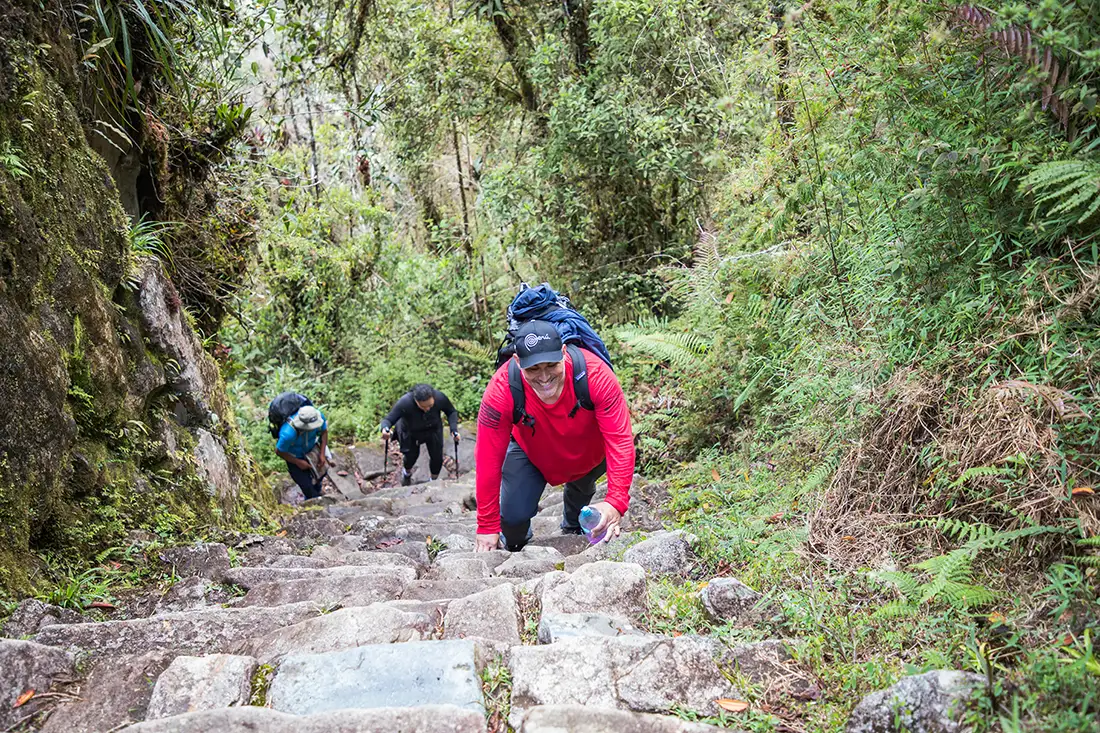
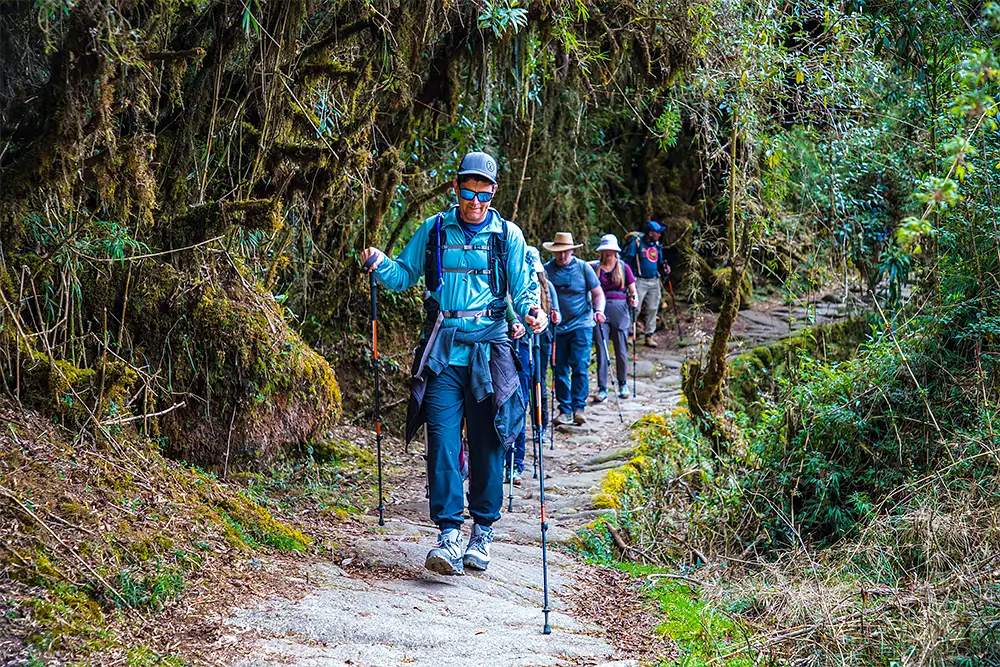
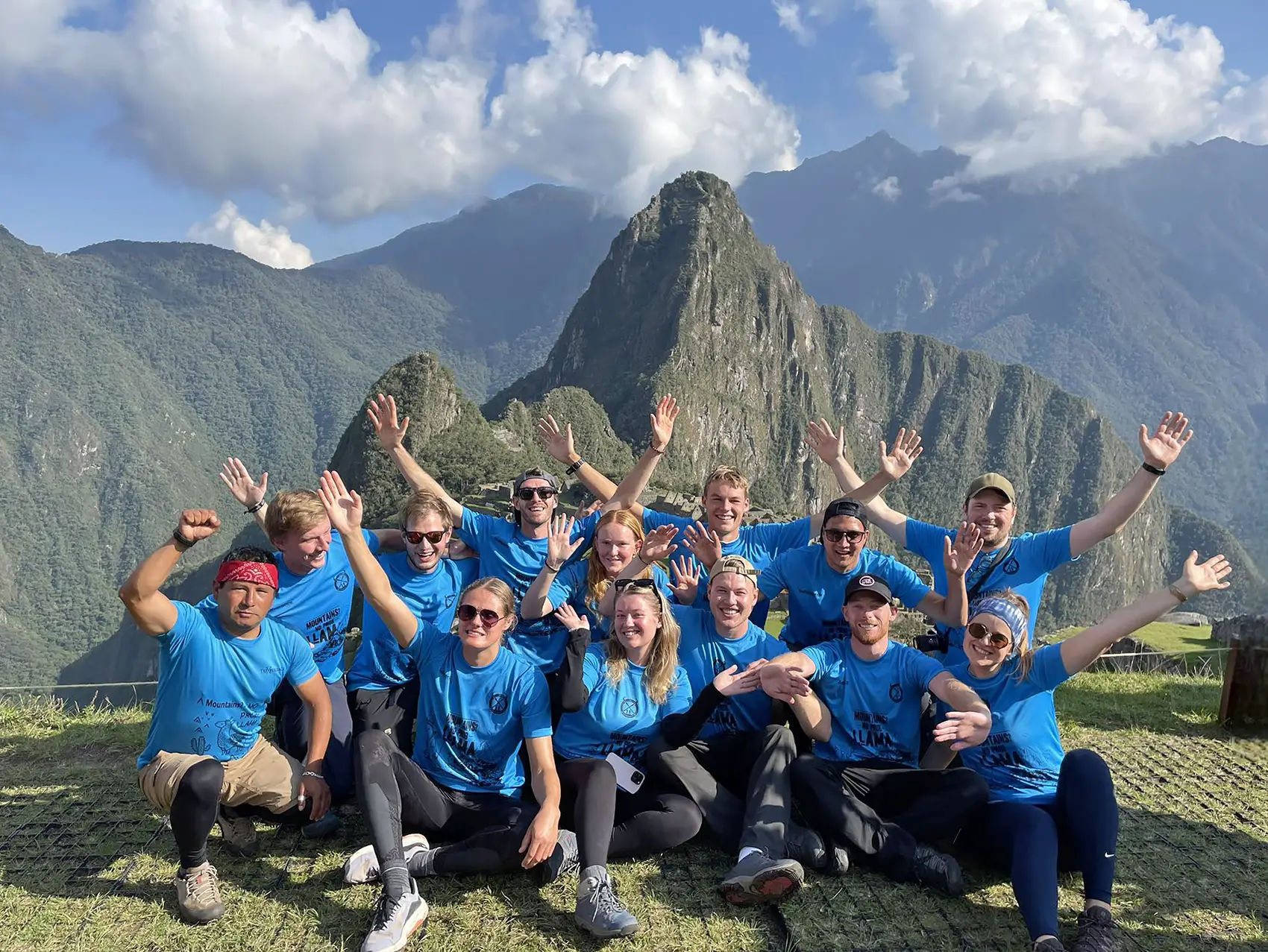
Inca Classic Trail
Dare to leave your comfort zone and experience the unique adventure of the Inca Trail towards Machu Picchu. Dive into the natural wonders of the Andes, explore ancient Inca sites steeped in history, connect with our local porters, and delight in authentic Peruvian cuisine. Along the way, you will make new friends and experience the thrill of reaching Machu Picchu through imposing mountains.
Walking the Inca Trail is more than just an excursion; is to rediscover the magic of hiking and camping, where the essential becomes an unforgettable journey that will mark your life forever.
Itinerary
Complete itinerary of the Inca Trail tour 4 days
Day 1: Cusco – Km 82 – Hatunchaca – Ayapata
The adventure on the Inca Trail begins at dawn, with the pick up at your hotel in Cusco around 4:30 a.m. If you are in the Sacred Valley, the pickup is a little later, at 6:00 a.m. Our first stop is in the picturesque town of Ollantaytambo, where you will enjoy breakfast with views of the mountains and Inca ruins. This is also the perfect time to make the last necessary purchases before starting the walk.
Around 8:00 a.m., we arrived at Km 82, the starting point of our journey to Machu Picchu. Here you will meet the complete team that will accompany you during the walk, including the chef, the porters and the expert guides.
The day begins with a two-hour gentle walk to Patallacta, an impressive archaeological site that we will observe from a viewpoint. We continue another two hours to Hatunchaca, a charming town where a delicious lunch prepared with fresh local ingredients awaits us.
After eating, we resumed our march for another two hours until we reached our first camp in Ayapata, at approximately 5:00 p.m. Upon arrival, you will find your tent ready to rest and enjoy a hot dinner before sleeping, preparing for the next day.
- Distance: 14 km / 8 miles
- Duration: 6 hours
- Camp altitude: 3,300 m / 10,826 ft
- Maximum altitude: 3,300 m / 10,826 ft
- Meals: Breakfast, snacks, lunch, tea, dinner
- Difficulty: Moderate
Day 2: Ayapata – Warmiwañuska – Chaquicocha
The second day begins with a hot coffee or coca tea served in your store. After a nutritious breakfast, we begin the most challenging section of the Inca Trail: a 4-hour climb to the Paso de la Mujer Muerta, the highest point of the route at 4,215 meters. At the top, we will enjoy a coca tea and a traditional ceremony guided by our guide, dedicated to the Apus, the spirits of the mountains.
We will descend for two hours towards the quiet valley of Pacaymayo Alto, where lunch will be served. Then, we will continue with a more gradual climb of 2 hours towards Runkuraqay Pass, at 4,000 meters of altitude. Along the way, we will explore two fascinating Inca sites: Runkuraqay and Sayacmarca.
We end the day in the Chaquicocha camp, at 3,600 meters of altitude. Here, you can enjoy a spectacular sunset over the Vilcabamba mountain range before dinner, and at night, a starry sky ideal for astronomical observation.
- Distance: 16 km / 10 miles
- Duration: 10 hours
- Camp altitude: 3,600 m / 11,811 ft
- Maximum altitude: 4,215 m / 13,829 ft
- Meals: Breakfast, snacks, lunch, tea, dinner
- Difficulty: Moderate to difficult
Day 3: Chaquicocha – Intipata – Wiñaywayna
After overcoming the most demanding day of the tour, the third day is more relaxed and full of spectacular views. We will walk for about 5 hours to the last camp, passing through different ecosystems, from the cloud forest to impressive views of the Salkantay peak, the second highest mountain in Cusco. We will visit two Inca sites: Phuyupatamarca, the «City in the Clouds », and the «Terraces of the Sun » in Intipata.
In Intipata, there will be time to rest and enjoy the magical surroundings before arriving at the camp for lunch around 1:00 p.m. In the afternoon, you can relax, walk around the camp or even take a refreshing shower. Later, we will explore the Inca site of Wiñaywayna, where the guide will share with you the history of this fascinating place. We will return to the camp for tea, dinner and a special surprise to conclude the day.
- Distance: 10 km / 6.2 miles
- Duration: 5 hours
- Camp altitude: 2,600 m / 8,530 ft
- Maximum altitude: 3,600 m / 11,811 ft
- Meals: Breakfast, snacks, lunch, tea, dinner
- Difficulty: Easy
Day 4: Discover Machu Picchu – Cusco
The highlight of the trip begins early with the walk to Machu Picchu, the iconic «Lost City of the Incas ». We head to the checkpoint at 5:30 a.m., and as the day begins to clear, we ascend for an hour to Puerta del Sol (Intipunku), enjoying stunning views along the way.
With any luck, the clear sky will allow us to witness a spectacular sunrise over Machu Picchu from Puerta del Sol, a truly unforgettable moment. Then, we will go down for another hour until we reach Machu Picchu around 8:00 a.m.
Here, your guide will take you on a full two-hour tour of the highlights of the citadel. If you wish, you can climb the Huayna Picchu mountain (upon reservation of tickets). After the tour, we will descend by bus to Aguas Calientes for lunch and then take the panoramic train back to Ollantaytambo. From there, the TreXperience team will take you back to your hotel in Cusco or the Sacred Valley, arriving at approximately 7:30 p.m.
- Distance: 6 km / 3.7 miles
- Walking duration: 2-3 hours
- Maximum altitude: 2,700 m / 8,858 ft
- Meals: Breakfast, snacks
- Difficulty: Easy to moderate
Climate
The Climate on the Inca Trail to Machu Picchu: What to Expect in Your 4 Day Adventure
The Inca Trail to Machu Picchu is one of the most iconic hiking trails in the world, attracting thousands of travelers each year in search of a unique experience that combines history, culture and the impressive natural beauty of the Peruvian Andes. To fully enjoy this adventure, it is essential to understand the climatic conditions that you will face during the four days of walking. This article will help you prepare for the various climates that you will find on the Inca Trail, so that you can pack properly and be ready for what nature has in store for you.
General Climate of the Inca Trail
The Inca Trail is located in the Andean region of Peru, where the climate can be quite unpredictable due to the altitude and mountainous terrain. The route ranges from 2,600 meters (8,530 feet) to 4,215 meters (13,829 feet) above sea level, causing significant changes in weather conditions over distances and short times.
There are two main seasons: the dry season and the rainy season. The dry season, which runs from May to September, is the most popular time to do the Inca Trail, as conditions are more predictable and rains are minimal. During the rainy season, from November to March, the trail can become slippery and more challenging due to frequent rainfall. April and October are transition months, in which the climate can vary, combining sunny days with occasional rains.
Day 1: Cusco – Km 82 – Ayapata
On the first day of the Inca Trail, you will start your adventure early in the morning in Cusco, where temperatures are usually cool, especially in the dry season, with lows that can be around 5 ° C (41 ° F) in the early morning. As you progress towards kilometer 82, the official starting point of the walk, and start walking towards Ayapata, the weather begins to heat up, especially at noon, with temperatures that can reach 20 ° C (68 ° F).
During this first day, you may find a mixture of sun and clouds. If you hike in the dry season, it is unlikely to rain, but it is always advisable to wear a light waterproof jacket in case of unexpected rains. In the rainy season, rainfall is more frequent, so it is essential to have adequate clothing for the rain and a good poncho.
Day 2: Ayapata – Warmiwañuska – Chaquicocha
The second day is known for being the most challenging of the Inca Trail, not only for physical effort, but also for significant climatic changes. You will begin by ascending towards the Dead Woman Pass (Warmiwañuska), which is the highest point of the entire route at 4,215 meters (13,829 feet). At this altitude, the climate can be quite cold, especially in the morning, with temperatures that can drop below 0 ° C (32 ° F).
As you climb, you will likely find fog and wind, which can increase your cold feeling. During the dry season, mornings are cool, but clear skies can offer a strong midday sun, making clothing layers essential to adapt to temperature fluctuations. In the rainy season, you can expect showers, especially when approaching the highest pass, so it is important to have waterproof and warm clothing.
After the pass, the descent into the Pacaymayo Alto valley and the Chaquicocha camp brings with it a milder climate, but it can still be cool at night. Camp temperatures can vary between 5 ° C (41 ° F) and 10 ° C (50 ° F), depending on the season.
Day 3: Chaquicocha – Intipata – Wiñaywayna
The third day of the Inca Trail is considered by many to be the most beautiful and relaxed. During this section, you will walk through various microclimates and ecosystems, from the cloud forest to more open areas with panoramic views of the mountains.
The climate in this part of the route is generally milder, with daytime temperatures ranging from 15 ° C (59 ° F) to 25 ° C (77 ° F). It is a perfect day to walk in light clothing, but it is always good to have a jacket on hand for when you stop in the Inca ruins like Phuyupatamarca and Intipata, where the breeze can feel fresh.
In the rainy season, there is a greater probability of encountering light rains or drizzles, especially when walking through the sections of the cloud forest. It is important to keep your belongings dry with waterproof bags inside your backpack. In the afternoon, upon arrival at the Wiñaywayna camp, temperatures are moderate, providing a pleasant night to rest before the grand finale.
Day 4: Wiñaywayna – Machu Picchu – Cusco
The last day of the walk is an exciting highlight, with the arrival at Machu Picchu. You will start the day before sunrise, with a cool weather in Wiñaywayna, usually around 10 ° C (50 ° F). As you walk towards Puerta del Sol (Intipunku), temperatures gradually increase with sunrise.
The view from Puerta del Sol may vary depending on the season. During the dry season, the skies are usually clear, offering a spectacular sunrise over Machu Picchu. However, in the rainy season, the mist is common and can obscure the views, but it also adds a mystical air to the experience.
Once in Machu Picchu, the climate is usually warmer, with daytime temperatures ranging from 15 ° C (59 ° F) to 25 ° C (77 ° F). It is important to bring sunscreen, a hat, and enough water to stay hydrated as you explore the citadel.
Tips to Prepare According to the Climate
- Pack in Layers: Due to the variability of the climate, it is crucial to pack clothes in layers to easily adapt to changes in temperature. Consider breathable shirts, light sweaters, waterproof jackets, and warm clothing for cold nights.
- Protection Against the Sun: Although temperatures can be cool, altitude means increased exposure to UV rays. He wears high-protection sunscreen, sunglasses, and a wide-brimmed hat.
- Waterproofing: During the rainy season, make sure your entire team, especially your clothes and sleeping bag, is protected against water. Use waterproof covers for backpacks and dry bags for your belongings.
- Suitable Shoes: Waterproof and well-supported hiking boots are essential for handling slippery terrain and avoiding injury.
Sites Visited
Archaeological Sites You Will Visit on the 4-Day Classic Inca Trail to Machu Picchu
The 4-day Classic Inca Trail to Machu Picchu is not only an impressive adventure through the nature of the Andes, but also a journey through Inca history. Along this tour, there are several fascinating archaeological sites that offer a deep insight into Inca civilization and its incredible ability to build on one of the most challenging terrain on the planet. In this article, we will explore the main sites you will visit on this iconic hike.
Patallacta: The Gateway to the Andes
One of the first places to visit when starting the Inca Trail is Patallacta. This place, whose name means «Town in the Height », is strategically located on a hill overlooking the surrounding valleys. Patallacta served as an important agricultural and control center for the Incas, who managed commercial and communication routes along the Andes.
From the observation point, walkers can see the agricultural terraces that were once used to cultivate various essential products for the Incas. These terraces were designed to maximize land use and manage water efficiently, a testament to the agricultural ingenuity of the Incas.
Runkuraqay: The Road Controller
Runkuraqay It is a semi-circular structure that appears on the second day of the walk, halfway to the highest pass of the Inca Trail. This small but fascinating site is believed to have been a drum or rest station, used by Inca messengers known as chasquis, who carried messages across the vast empire.
Runkuraqay's design suggests that it may also have had surveillance functions, as its location allows a wide view of the valley. Semi-circular structures and site location indicate that it was a key place to control the movement of people and goods along the way.
Sayacmarca: The Inaccessible City
Name Sayacmarca means «Inaccessible City », and when you get there, you will understand why. This site is located on top of a rocky cliff, making it accessible only via a steep stone path. Sayacmarca probably served as a checkpoint and refuge site for Inca travelers.
The site offers an impressive panoramic view of the surrounding valleys and has a complex of houses, squares and water sources that still function. Sayacmarca's strategic location allowed the Incas to maintain control of the region's trails and also provide safe haven in times of war or conflict.
Phuyupatamarca: The City in the Clouds
Phuyupatamarca, known as the «City on the Clouds », is one of the most impressive archaeological sites on the Inca Trail. This place is at high altitude and is often shrouded in mist, giving it a mystical air. Phuyupatamarca is famous for its elaborate water fountains and ritual baths, which are believed to have been used for ceremonial purposes.
The site is made up of a series of terraces, stairs and water channels, designed to make the most of the water from nearby natural springs. These characteristics reflect the deep Inca knowledge of hydraulic engineering and its ability to integrate its constructions with the natural environment.
Intipata: Las Terrazas del Sol
Intipata, which means «Terraces of the Sun », is a beautiful archaeological site known for its extensive agricultural terraces that cascade down the side of the mountain. These terraces were used by the Incas to cultivate a variety of crops and also to stabilize the mountainous terrain.
The site offers spectacular views of the Urubamba River and the surrounding mountains. Intipata is an excellent place to stop and enjoy the scenery while learning about the agricultural and construction techniques used by the Incas.
Wiñaywayna: Always Young
Wiñaywayna, which means «Siempre Joven », is the last important archaeological site to be visited before reaching Machu Picchu. This site is famous for its terrace construction and for the beautiful waterfalls that flow through the valley. Wiñaywayna served as an important agricultural and religious center on the Inca Trail.
The complex is made up of two sectors: one agricultural, with numerous terraces, and the other urban, with religious and residential buildings. Wiñaywayna offers one last chance to immerse yourself in Inca history before completing the walk at Machu Picchu.
Intipunku: The Puerta del Sol
Intipunku, also known as the «Puerta del Sol », it is one of the most emblematic sites of the Inca Trail, especially since it is the final gateway to Machu Picchu. This site is a strategic control point built to supervise the entrance to the sacred citadel of Machu Picchu.
Upon reaching Intipunku, you will be greeted with an impressive view of Machu Picchu as the sun rises over the mountains, illuminating the citadel in a spectacle of natural light. This place not only offers an unforgettable view, but also symbolizes the culmination of days of arduous walking and the arrival at one of the most sacred and mysterious places in the Inca world.
Machu Picchu: The Lost City of the Incas
Finally, the tour culminates in the famous Machu Picchu, one of the Seven Wonders of the Modern World and a UNESCO World Heritage Site. Machu Picchu is the most anticipated destination on the Inca Trail and offers a truly magical experience. This Inca citadel, located between mountains, was built in the 15th century and abandoned during the Spanish conquest.
The site is famous for its intricate architecture, its temples, terraces, and squares, as well as its stunning views of the Andes and the Urubamba River. A guided tour of Machu Picchu provides a deeper understanding of Inca culture and its incredible ability to build in such a challenging environment.
What to bring?
What to Pack for the Inca Trail to Machu Picchu: Practical Guide
Preparing well for the Inca Trail to Machu Picchu is key to enjoying a safe, comfortable and pleasant experience. This 4-day route through the Peruvian Andes combines spectacular landscapes, physical challenges, and fascinating archaeological sites. Because the weather and terrain can be unpredictable, it is important to bring the right equipment to be prepared for any situation. In this guide, we will explain what to pack for your adventure on the Inca Trail, making sure you carry everything you need without carrying too much weight.
Clothing and Footwear: Key to the Comfort
One of the most important aspects when packing for the Inca Trail is choosing clothes well. Temperatures can vary greatly during the day and night, so it is essential to be ready for these changes.
- Hiking Boots: Comfortable, tight hiking boots are essential. They must be waterproof and provide good ankle support to avoid injury to rugged terrain. Be sure to use them before the walk to avoid blisters and discomfort.
- Clothes in Layers: Packing clothes in layers is key due to temperature variations. Wear long-sleeved, short-sleeved shirts of breathable materials, a polar lining or light sweater for the cold, and a waterproof jacket to protect you from rain and wind.
- Hiking Pants: He wears light and comfortable hiking pants. It is recommended that they be convertible, that is, that they can be transformed into shorts. It is also useful to bring an extra pair for the colder days or to rest in the camp.
- Hiking Socks: Specialized merino wool or hiking socks will help keep your feet dry and comfortable, avoiding blisters. It has at least three pairs and considers an additional pair for the camps.
- Quick Dry Underwear: Opt for underwear that is breathable and quick to dry to keep you dry and comfortable throughout the walk.
- Cap and Gloves: A wool hat for cold mornings and light gloves are useful, especially in the highest parts of the road, where it can be quite cold.
- Sun hat and sunglasses: At higher altitudes, UV radiation is more intense, making a wide-brimmed hat and good quality sunglasses essential to protect you from the sun.
Essential Equipment and Accessories
In addition to the right clothing, there are various equipment and accessories that are essential for a safe and comfortable hiking experience on the Inca Trail.
- Day Backpack: A comfortable backpack of about 20-30 liters is perfect for carrying the essentials during the daily walk, such as water, sandwiches, sunscreen and additional clothing. Choose one with padded straps and hip belts to distribute weight evenly.
- Waterproof Cover for Backpack: Since the weather can change rapidly in the Andes, it is important to carry a waterproof cover for your backpack and thus keep your belongings dry in case of rain.
- Sleeping bag: A sleeping bag suitable for temperatures up to -10 ° C (14 ° F) is essential, especially during the dry season, when the nights can be quite cold. Make sure it is light and easy to pack.
- Bedding mat: A light mat provides additional insulation and comfort for sleeping in the camp. Some trekking companies provide them, but carrying yours can be a good idea for added comfort.
- Hiking sticks: Hiking poles are very useful for providing additional support on uneven terrain and reducing impact on the knees during descents. Make sure they are adjustable and lightweight.
- Front Flashlight and Spare Cells: A front flashlight is essential for early mornings and nights at camp. Don't forget to bring spare batteries.
- Reusable Water Bottle or Hydration System: Staying hydrated is key on the Inca Trail. It has a reusable water bottle or a hydration system with a capacity of at least 2 liters. Also consider bringing tablets or filters to purify the water.
Food and Health
Maintaining your energy and physical well-being is essential to enjoy the walk, so be sure to bring what is necessary to stay active and healthy.
- Energy Snacks: Bring light and energetic snacks such as nuts, granola bars, dehydrated fruits and chocolates. These will give you an energy boost when you need it most.
- First Aid Kit: A small first aid kit is essential. Includes bandages, disinfectant, pain relievers, height medication, and any personal medications you need.
- Solar Protection: The sun in the Andes can be very strong, so it is important to bring high protection sunscreen (SPF 30 or more), lip balm with sun protection and insect repellent.
Personal Toilet Items
Maintaining hygiene during the walk is also important. Here are some essential toiletries:
- Wet Wipes and Hand Disinfectant: Wet wipes are useful for quick cleaning when water is limited. The hand sanitizer will help you stay clean before eating or after using the toilets.
- Brush and Toothpaste: Bring a toothbrush and a small amount of toothpaste. Opt for travel sizes to save space and weight.
- Toilet Paper and Plastic Bags: Bring enough toilet paper and plastic bags to store personal trash. It is important to follow the «Don't Scratch » rules to protect the natural environment.
Documents and Money
It is essential to have the necessary documents and some cash with you during the walk.
- Passport: You will need your passport to enter the Inca Trail and to enter Machu Picchu. Be sure to take it in a safe and dry place.
- Entrance Ticket to Machu Picchu: Although the tour operator generally organizes this, it is important to have a copy of your ticket to Machu Picchu.
- Cash: Take some cash in Peruvian soles for possible additional expenses, such as buying extra water or snacks along the way or tipping porters and guides.
Additional Tips for Packing
- Pack Light: Although it may be tempting to carry more «just in case », remember that anything extra is additional weight that you will have to carry. Keep your luggage as light as possible while making sure you have the essentials.
- Use Compression Bags: Compression bags can help you reduce the volume of clothing and camping equipment, making it easy to pack and transport.
- Protect yourself Against the Rain: The weather in the Andes can change quickly, so make sure all your clothes and equipment are protected from rain using waterproof bags or backpack covers.
History
The History of the Inca Trail to Machu Picchu: A Journey Through Time
The Inca Trail to Machu Picchu is not just a hiking route; It is a route that connects you with the rich history of one of the most fascinating civilizations in the world. This path, which winds through the imposing Peruvian Andes, shows the ingenuity and skill of the Incas, who built an extensive network of roads to connect their entire empire. In this blog, we will explore the history of the Inca Trail, how it was built, its original purpose, and how it has become one of the most famous walks in the world.
The Origins of the Inca Trail
The Inca Trail is part of a large network of roads known as Qhapaq Ñan, which in Quechua means «The King's Way ». This network spanned about 40,000 kilometers through the ancient Inca Empire, which covered parts of present-day Peru, Ecuador, Bolivia, Chile, Argentina, and Colombia. The Incas began building these routes in the 15th century, under the leadership of Pachacútec, one of the empire's most important emperors.
The Qhapaq Ñan it was not just a series of roads; it was essential for the administration and control of the vast Inca territory. It facilitated the rapid movement of armies, the transportation of goods and food, and communication between different regions and administrative centers. It also aided in trade and tax collection, and was essential to maintaining the empire's political and cultural unity.
Construction and Architecture of the Inca Trail
The construction of the Inca Trail demonstrates the advanced engineering knowledge of the Incas. Despite the challenges of the mountainous and sometimes hostile terrain of the Andes, the Incas managed to build lasting roads that have resisted the passage of time. They used local materials such as stone and mud, and applied techniques that allowed the roads to adapt to the natural topography of the terrain.
The roads were designed to resist erosion and landslides, with intelligent drainage systems that prevented water from accumulating. In some parts of the Inca Trail, the trails are paved with flat stones, and stairs and tunnels were built in steeper or more difficult sections. String suspension bridges, made of natural fibers such as ichu (a kind of Andean straw), were common in sections that crossed rivers and deep canyons.
The section of the Inca Trail that leads to Machu Picchu, known as the Classic Inca Trail, is only a small part of this vast network. This path is famous not only for its impressive natural beauty, but also for its historical and spiritual importance. Machu Picchu, often called the «Lost City of the Incas », was an important religious, political and cultural center, and the roads leading to it were not only for transportation, but also for sacred ceremonies.
The Purpose of the Inca Trail and Machu Picchu
The Inca Trail and the trails leading to Machu Picchu were not simply travel routes. They had a deep spiritual meaning and were used for religious pilgrimages and ceremonies. Mountains, sun, moon, and stars were regarded by the Incas as deities, and many of their paths and structures were aligned with astronomical events.
Machu Picchu, located 2,430 meters above sea level, was built during the heyday of the Inca Empire, in the 15th century, probably under the government of Pachacútec. Although its exact purpose remains a mystery, many archaeologists believe that it may have been a royal summer residence, a religious center, or a strategic refuge in the event of war. Its location, surrounded by sacred mountains and overlooking the Urubamba River, suggests that it was also of great spiritual importance.
The Rediscovery of Machu Picchu and the Inca Trail
For centuries Machu Picchu remained hidden and was only known to some local inhabitants. It was in 1911 when the American explorer Hiram Bingham, guided by local peasants, «rediscovered » Machu Picchu and made it known to the world. Bingham was searching for the lost city of Vilcabamba, the last refuge of the Incas during the Spanish conquest, but instead found this impressive Inca citadel.
Machu Picchu's discovery aroused great interest in Inca history and on the Inca Trail. In the following decades, archaeologists and historians worked to map and study archaeological sites and pathways along this sacred route. As knowledge of the Inca Trail grew, so did its popularity among adventurers and tourists who wanted to explore the wonders of the ancient Inca Empire.
The Inca Trail Today: A World Class Hiking Destination
Today, the Inca Trail is considered one of the best hiking trails in the world, attracting thousands of travelers each year. The 4-day section known as the Classic Inca Trail It is the most popular, starting at kilometer 82 of the train line that goes from Cusco to Aguas Calientes, and passing through several Inca archaeological sites before reaching Machu Picchu.
This route not only offers stunning views of mountains, valleys, and cloud forests, but also takes walkers through important Inca archaeological sites, such as Patallacta, Runkuraqay, Sayacmarca, Phuyupatamarca, Wiñaywayna, and finally Intipunku, Puerta del Sol, from where you can see Machu Picchu for the first time.
To protect the Inca Trail and Machu Picchu, the Peruvian government has implemented conservation measures, limiting the number of people who can walk the route each day and establishing strict rules to preserve the natural and archaeological environment. Access is only allowed with authorized guides, and tourists must obtain permits months in advance due to high demand.
The Cultural and Spiritual Impact of the Inca Trail
For many, walking on the Inca Trail is more than a physical challenge; It is a transformative experience that connects people with the history and spirituality of the Incas. Each step on the path is an opportunity to reflect on the greatness of a civilization that dominated the Andes for centuries, building cities and roads that still amaze us today for their complexity and beauty.
The Inca Trail is not only a trip to Machu Picchu, but also an interior trip, an opportunity to disconnect from the modern world and connect with nature and history. Andean rituals, such as offerings to Pachamama (Mother Earth), remain part of the experience, reminding walkers of the importance of respecting and honoring the natural and cultural environment.
Flora & Fauna
Flora and Fauna on the Inca Trail to Machu Picchu: An Adventure in Nature
The Inca Trail to Machu Picchu is not only a journey through Inca history, but also an exploration of the incredible biodiversity of the Peruvian Andes. Along this famous hiking trail, travelers encounter a variety of landscapes ranging from dense cloud forests to high mountain moors. This diversity of environments creates the perfect home for a rich variety of plants and animals, making the Inca Trail a unique experience for nature lovers. In this blog, we tell you about some of the most outstanding species of flora and fauna that you can discover on your way to Machu Picchu.
The Flora of the Inca Trail
The different altitudes and microclimates along the Inca Trail allow a wide variety of plants to grow. From bright flowers to imposing trees and giant ferns, the flora on the Inca Trail is diverse and fascinating.
Orchids: The Jewels of the Andes
One of the biggest attractions of the Inca Trail are the orchids. Peru is home to more than 3,000 species of orchids, and many of them can be found along the way. In the cloud forests surrounding the route, you will see vibrantly colored orchids growing on trees, rocks, and on the ground. Some, like the Epidendrum, are famous for their fragrant and colorful flowers, while others, such as the Masdevallia, stand out for their unique shapes and intense colors.
In addition to beautifying the landscape, orchids are essential to the local ecosystem. These plants are pollinated by various insects and birds, which helps maintain the region's biodiversity.
Giant Ferns: Guardians of the Cloud Forest
Another outstanding plant of the Inca Trail are the giant ferns. Some of these ferns can reach up to 10 meters in height and are common in cloud forest areas. Giant ferns, like the CyatheaThey belong to an ancient group of plants that have existed since the time of the dinosaurs, making them true living fossils.
These ferns not only offer refuge to many species of animals, but also help regulate the microclimate of the cloud forest by retaining moisture. Its presence adds a touch of mystery and antiquity to the landscape of the Inca Trail.
Trees and Medicinal Plants
As you advance on the Inca Trail, you will find a variety of trees and medicinal plants that local communities have used for centuries. The quina tree, for example, it is known for its medicinal properties and is the national tree of Peru. Its bark and leaves have traditionally been used to treat different diseases, including fever and malaria.
Another important plant is the muña, an aromatic herb that grows in the upper areas of the road. The grime is used in traditional Andean medicine for digestive problems and also as a natural remedy for altitude sickness. The presence of these plants not only highlights the botanical richness of the area, but also the ancestral knowledge of local communities about the use of plants for health.
The Fauna of the Inca Trail
The Inca Trail is also home to a wide variety of animals. From colorful birds to rare mammals, the wildlife on this hiking trail is diverse and exciting.
Birds of the Inca Trail: A Paradise for Observers
Birds are one of the main attractions of the Inca Trail. Along the route, you can find a wide variety of species, from small songbirds to large birds of prey. One of the most emblematic is the rock cock (Rupicola peruvianus), the national bird of Peru. With its bright red plumage and distinctive crest, this bird is a wonderful sight for those lucky enough to see it.
Other notable birds include the Andean toucan and various species of hummingbirds, such as the giant hummingbird and the sword-billed hummingbird. The cloud forests of the Inca Trail are the ideal home for these vibrant little birds, which feed on the nectar of flowers and contribute to the pollination of plants.
Andean Mammals: Rare and Protected Species
The Inca Trail also houses a variety of mammals adapted to life in the mountains. One of the best known is the vicuña (Vicugna vicugna), a wild relative of the flame famous for its soft and fine wool. Vicuñas are shy animals, but they can be seen in some more remote areas of the road, grazing in the high moors.
Another notable mammal is the spectacled bear (Tremarctos ornatus), the only bear native to South America. This bear, also known as the Andean bear, is endangered and famous for the white markings around its eyes that look like glasses. Although it is rare to see these bears on the Inca Trail, their presence in the region reminds us of the importance of conserving these natural habitats.
Reptiles and Amphibians
The reptiles and amphibians they are also part of the Inca Trail ecosystem. There are various species of lizards and frogs, some of which are unique to the region. Frogs, like andean marsupial frog, are especially interesting for their ability to adapt to the cold temperatures of the Andean heights. These small animals are often found near streams and ponds, where you can also see small snakes and other reptiles that hide among the rocks and vegetation.
The Importance of Conservation
The rich flora and fauna of the Inca Trail highlights the importance of protecting these unique ecosystems. The increase in tourism has brought economic benefits to local communities, but it also presents challenges for preserving the natural environment. It is essential that visitors respect the park's rules and practice responsible tourism, following the principles of «do not leave a trace » to minimize the impact on the environment.
Conservation efforts are essential to protect the biodiversity of the Inca Trail and ensure that future generations can enjoy this incredible natural wealth. This includes supporting local initiatives that seek to preserve native species and their habitats, as well as promoting education and environmental awareness among visitors.
Tips
Tips for Making the Inca Trail to Machu Picchu: What You Must Know
The Inca Trail to Machu Picchu is one of the most famous hiking trails in the world. It combines spectacular landscapes, the rich history of the Incas and physical challenges that challenge adventurers. For many, this 4-day walk through the Peruvian Andes is a once in a lifetime experience. However, to make the most of it, it is important to be well prepared. Here we offer you some essential tips to make your adventure on the Inca Trail memorable.
Reserve with Anticipation
The Inca Trail is very popular and has a daily limit of visitors to protect the natural and archaeological environment. Only 500 people a day are allowed, including porters and guides. Therefore, it is crucial to reserve your place several months in advance, especially if you want to go during the high season (from May to September). Reservations usually open a year in advance, so plan ahead to secure your space.
Acclimatize to Altitude
One of the biggest difficulties of the Inca Trail is altitude. The walk begins at more than 2,500 meters above sea level and reaches 4,215 meters in the Paso de la Mujer Muerta. Lack of oxygen at this point can cause altitude sickness, with symptoms such as headache, dizziness, nausea, and fatigue.
To reduce the risk of altitude sickness, it is essential to acclimatize properly. The ideal is to spend at least two or three days in Cusco or the Sacred Valley before starting the journey. During this time, avoid making intense physical effort, stay well hydrated, and eat light meals. You may also consider using medications such as acetazolamide, but consult your doctor before taking any medication.
Pack Light, but with the Necessary
Carrying the right equipment is key to a comfortable and safe walk. However, it is important not to overload yourself with unnecessary weight. Here are some essential items to pack:
Layered clothing: Temperatures can change a lot during the day and night, so it is important to wear layered clothing. Includes long-sleeved, short-sleeved shirts, a sweater, a waterproof jacket, and pants that can be converted into shorts.
Comfortable hiking boots: Make sure they are waterproof and provide good ankle support. It is important that you have already used them before the walk to avoid blisters.
Sunscreen: Don't forget sunglasses, a wide-brimmed hat, and high-protect sunscreen to protect you from the strong sun above.
Hiking poles: They are useful for giving additional support on difficult terrain and reducing pressure on the knees when going down.
Reusable water bottle: Stay hydrated carrying enough water. Some tour operators provide water, but it is always good to bring a reusable bottle or hydration system.
Train Before the Walk
The Inca Trail is challenging, especially if you are not used to hiking at high altitudes. To prepare physically, it is advisable to start a training program at least two or three months before your trip. Includes regular walks on varied terrain, cardiovascular exercises, and leg strengthening and endurance. Practicing with a loaded backpack will help you get used to the extra weight you will carry along the way.
Be respectful of the Environment and Local Culture
The Inca Trail passes through areas of great cultural and natural value. It is important to respect both the environment and local communities. Follow the principles of «leave no trace »: take all your garbage with you, use the designated bathrooms and avoid damaging the local flora and fauna. Respect the park's rules and follow your guide's instructions at all times.
It is also essential to be respectful of local communities and their traditions. Learn a few words in Quechua, the language of the Incas that is still spoken in the region, and show respect for the cultural practices and values of the people you meet along the way.
Maintain a Positive Attitude and Enjoy the Path
The Inca Trail can be physically demanding, especially on high-altitude promotion days or when the weather is unpredictable. Maintaining a positive attitude is essential to enjoy the experience. Remember that each step brings you closer to Machu Picchu and the great reward of reaching one of the wonders of the world. Maintain motivation, enjoy every moment and take advantage of the company of your travel companions.
Hydrate and Feed Well
Staying well hydrated is essential, especially at high altitudes. Drink water regularly during the walk and avoid alcoholic beverages and caffeine, as they can dehydrate you. Bring energetic snacks like nuts, granola bars, dehydrated fruits, and chocolates to keep your energy levels high throughout the day.
Most trekking companies offer meals during the walk, which generally include hot and nutritious dishes. Take advantage of these meals to stay strong and energized throughout the walk.
Protect Your Health
In addition to being aware of the effects of altitude, it is important to protect yourself from the sun, cold, and insects. Use sunscreen and lip balm with SPF, and apply insect repellent, especially in cloud forest areas. It is also helpful to bring a small first aid kit with pain relievers, bandages, disinfectant, and any personal medications you may need.
Take advantage of the Maximum to Guides and Carriers
Guides and porters are a fundamental part of the Inca Trail experience. Not only do they help you load your gear and prepare meals, but they also share their knowledge of Inca history and culture. Take the opportunity to learn from them, ask questions and learn more about life in the Andes. It is also important to be considerate and show gratitude for your work. Many people choose to tip at the end of the trip as a token of appreciation.
Enjoy the Trip and Live the Moment
Finally, remember that the Inca Trail is not only a journey to a destination, but an experience in itself. Each day of the walk offers new views, challenges and opportunities to connect with Inca nature and history. Take the time to enjoy the scenery, listen to the sounds of the cloud forest, watch the birds and flowers, and appreciate every moment of the trip. This is a path that not only takes you to Machu Picchu, but also offers you the opportunity to rediscover yourself.
Regulations
Regulations on the Inca Trail to Machu Picchu: Everything You Need To Know
The Inca Trail to Machu Picchu is one of the most popular hiking trails in the world, famous for its impressive natural beauty, its deep Inca history and its great cultural value. To protect this route and conserve its natural and archaeological environment, the Peruvian government has established a series of strict rules. These regulations not only help preserve the Inca Trail for future generations, but also guarantee a safe and organized experience for all who visit it. Below, we explain the main rules you should know before embarking on this incredible adventure.
Daily Visitor Limit
One of the main regulations of the Inca Trail is the limit on the number of people who can enter the trail every day. Currently, only a maximum of 500 people per day are allowed, including guides, porters and cooks. This means that only around 200 to 250 tourists can start the walk each day. This limit has been established to reduce environmental impact and protect both the road and archaeological sites.
Due to this limit, it is essential to reserve your place several months in advance, especially if you plan to do the walk in the high season (from May to September). Reservations are usually sold out quickly, so it is advisable to plan at least six months in advance to secure a place.
Need to Go with an Authorized Agency
Another important rule is that all tourists who want to do the Inca Trail must hire the services of an authorized tourism agency. The walk is not allowed independently. Tourism agencies must be registered and approved by the Peruvian Ministry of Culture to operate on the Inca Trail. These agencies are responsible for obtaining the necessary permits, providing certified guides, and complying with all security regulations.
Hiring an agency not only ensures that you are complying with regulations, but also improves your experience on the Inca Trail. The agencies provide porters who carry part of the team, cooks who prepare meals along the way, and guides who offer you valuable information about Inca history and culture.
Entrance Permits to the Inca Trail
Entry permits to the Inca Trail are mandatory and must be managed in advance by the tourism agency of your choice. These permissions are personal and non-transferable. To apply for a permit, you will need to provide a copy of your current passport, since the permits are linked to your personal data. If you change your passport before the walk, be sure to bring both passports (the old and the new) or update your permit information with your tourism agency.
Permits also specify the start date of the walk, so they cannot be used on another date. It is important to plan your trip carefully, as permits are not refundable or interchangeable once issued.
Equipment and Weight restrictions
To minimize the environmental impact on the Inca Trail, there are restrictions on the type of equipment that can be carried and the weight allowed for carriers. Porters, who are essential to the Inca Trail experience, have a weight limit of 20 kg (44 pounds), which includes their own personal equipment. This limit has been established to protect the health and well-being of carriers and to minimize trail wear.
For this reason, tourists are encouraged to locate lightly and carry only the essentials. Tourism agencies generally provide bags for personal items to be carried by porters, while tourists should carry a small backpack with what is necessary for the day, such as water, sunscreen, snacks, and a waterproof jacket.
Single Use Plastics Ban
To reduce pollution and protect the environment, the Peruvian government has banned the use of single-use plastics on the Inca Trail and in the Machu Picchu sanctuary. This includes plastic bags, plastic water bottles, and disposable food containers. Visitors should use reusable water bottles, biodegradable or cloth bags, and reusable containers for their food.
Compliance with this regulation not only helps protect the natural environment of the Inca Trail, but also promotes sustainable tourism practices, essential to preserve this beautiful place for future generations.
Behavioral and Conservation Standards
Visitors to the Inca Trail must follow strict rules of behavior and conservation. These rules include not leaving trash on the trail, not picking up plants or flowers, not disturbing local animals, and not damaging archaeological sites. Tourists must also stay on marked trails to prevent erosion and reduce impact on the environment.
Tour guides play a crucial role in implementing these standards, educating tourists on the importance of conservation and ensuring that all rules are followed. It is essential that visitors respect these rules to protect the Inca Trail and its surroundings.
Drones ban
The use of drones is prohibited on the Inca Trail and in Machu Picchu. This rule was implemented to protect the privacy of visitors, maintain the tranquility of the site and avoid possible damage to local flora and fauna. Drones can also be a distraction or even a risk to other walkers. Therefore, if you are thinking of carrying a drone to capture images of the Inca Trail, you will have to leave it at home.
Camping Regulations
The Inca Trail has designated camps where groups can spend the night. Camping is not allowed outside of these places. These camps are managed by local authorities and tourism agencies to guarantee the safety of tourists and the preservation of the environment. In addition, these camping sites are equipped with bathrooms and, in some cases, with basic cooking facilities.
Safety and Health Measures
Safety is a priority on the Inca Trail. Authorized tourism agencies must comply with safety regulations, which include carrying first aid equipment, having certified guides with first aid training, and monitoring the health of walkers, especially in relation to altitude.
In an emergency, there are procedures to evacuate sick or injured walkers from the trail. It is important that tourists are honest about their health and follow the recommendations of their guides to ensure a safe experience.
Short Inca Trail
Summary
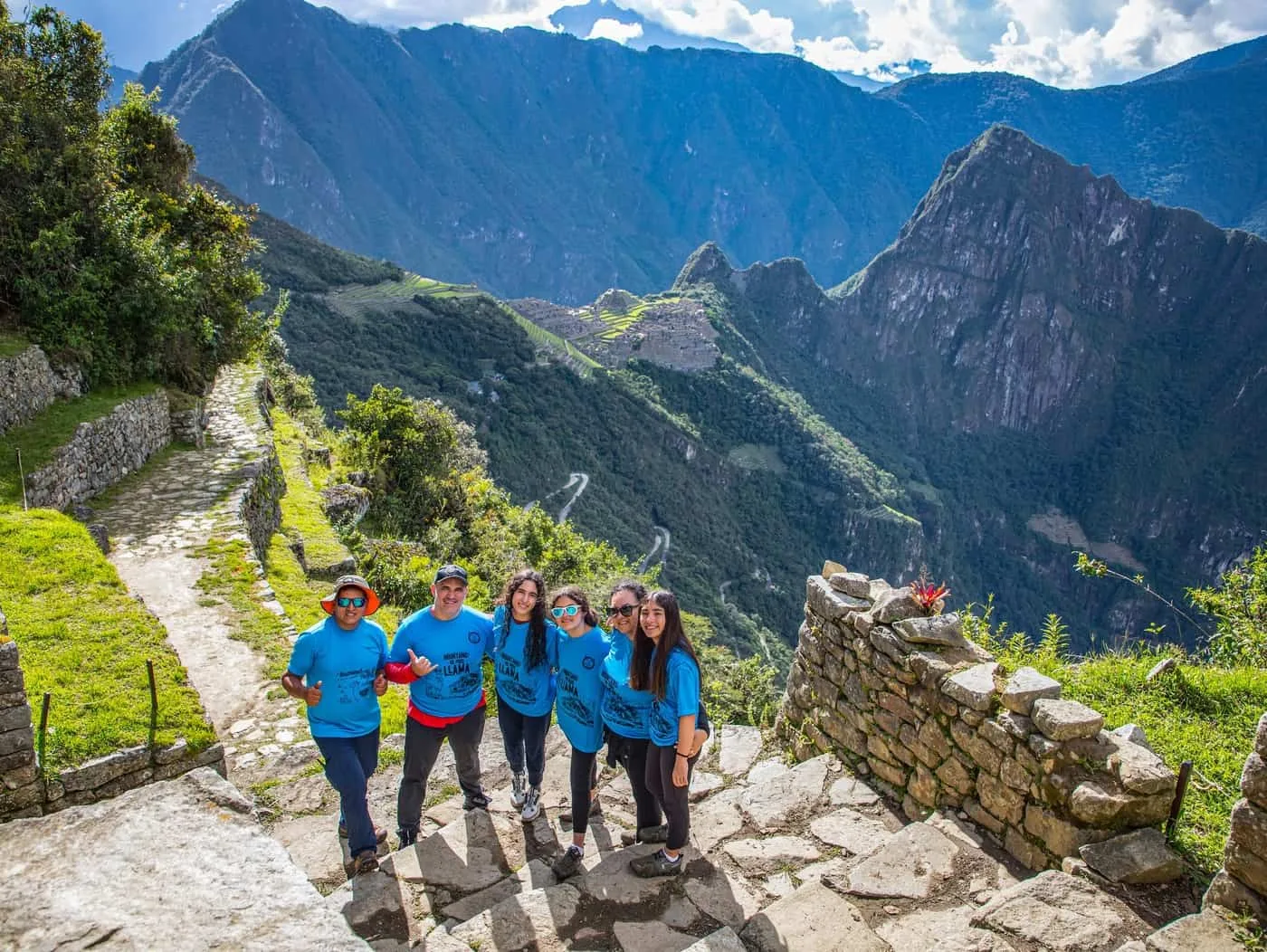
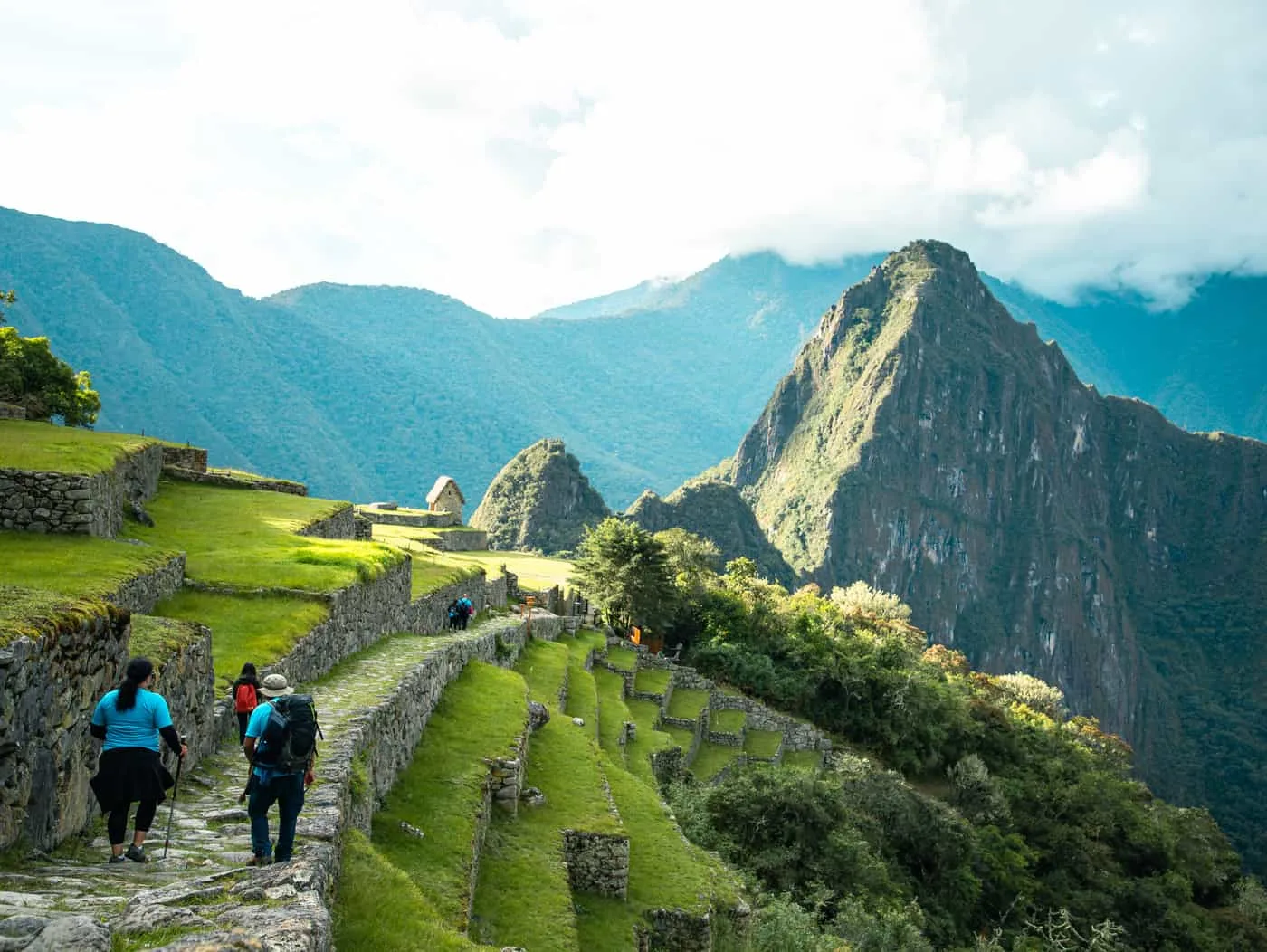
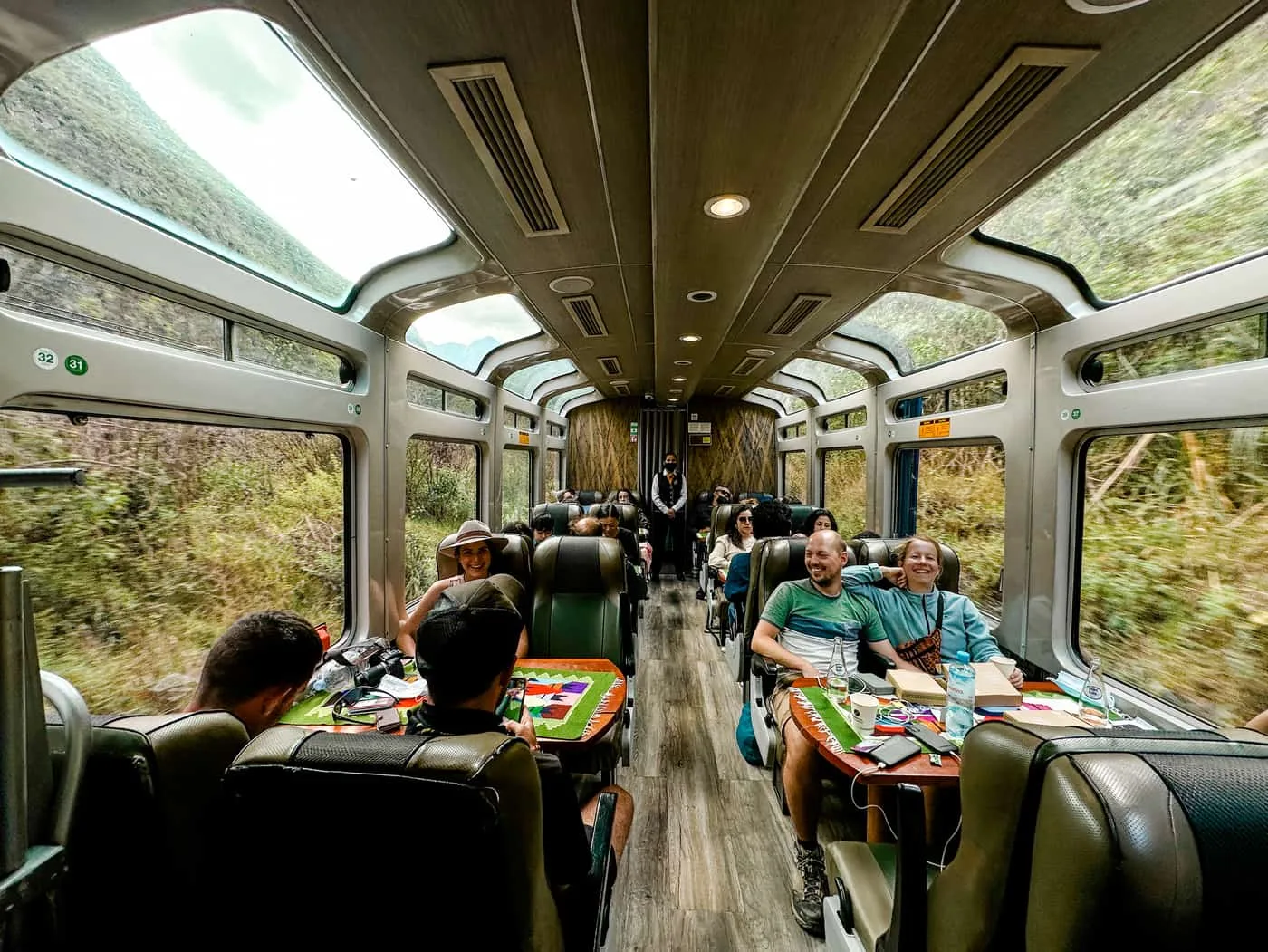
Inca Short Road
Live a unique experience on the Inca Short Trail 2 days and 1 night. You will start at Kilometer 104, exploring Inca sites like Chachabamba and Wiñaywayna, with their impressive Inca terraces. Then, you will walk to Puerta del Sol (Inti Punku), where the first spectacular view of Machu Picchu awaits you at sunset.
After spending the night in Aguas Calientes, you will return early to Machu Picchu for a guided tour that will allow you to discover its secrets and wonders. This tour is perfect for those who have little time but want to explore the Inca Trail and Machu Picchu.
Itinerary
Complete itinerary of the Inca Short Camino tour 2 days
Day 1: Cusco – Km 104 – Machu Picchu – Aguas Calientes
The day starts early with pick-up at your hotel in Cusco around 4:00 am, depending on the location. If your accommodation is in the Sacred Valley or in Ollantaytambo, the collection time will be at approximately 5:30 am.
For those who make the Inca Trail short, it is recommended to spend the night before near the train station in Ollantaytambo to reduce the travel time from Cusco by 1 hour and a half. If you have taken a tour in the Sacred Valley the day before, you can choose to stay in Ollantaytambo to depart directly from there. The TreXperience team will be able to pick you up both in Cusco and anywhere in the Sacred Valley.
The trip by private transport to the train station in Ollantaytambo takes around 1 hour and 30 minutes. From there, we will board a panoramic train that will follow the course of the Urubamba river until we reach the starting point of the trail at km 104 – Chachabamba, located in the lush vegetation of the cloud forest. Before starting the walk, you must show your original passport at the Chachabamba control. Here you will have time to prepare, use the services and stretch before starting.
The first stop will be the archaeological site of Chachabamba, where your guide will offer you an introduction to the history of the Inca Empire and the Inca Trail. After exploring this place, we will begin the walk along a section of the old path that was abandoned in the 16th century.
The walk begins with a gradual ascent of approximately 4 hours until reaching the impressive Wiñaywayna archaeological site, one of the most outstanding along the Inca Trail. Here we will explore its agricultural terraces and ceremonial structures, enjoying panoramic views of the Andes. During the walk, you will receive snacks and an organic box lunch. After a break, we will continue towards Puerta del Sol (Inti Punku), from where we will have the first view of Machu Picchu, a truly unforgettable moment.
After enjoying the views from Puerta del Sol, we will continue walking downhill for about an hour until we reach Machu Picchu, enjoying the almost empty site, a perfect opportunity to take pictures. Finally, we will take a bus to Aguas Calientes, where we will have dinner at a local restaurant and spend the night in a comfortable 3-star hotel.
- Walking distance: 13 km / 8 miles
- Duration: Approximately 7 hours
- Maximum altitude: 2,700 m / 8,858 ft
- Meals included: Lunch, snacks and dinner
- Accommodation: 3 star hotel in Aguas Calientes
- Difficulty: Moderate
Day 2: Visit to Machu Picchu – Return to Cusco
The second day will start very early with a breakfast at the hotel to be among the first to go up to Machu Picchu. At 5:30 am we will board the bus that will take us to the entrance of the sanctuary. The ascent is short but offers stunning views of the citadel. If the weather allows it, you can witness the sunrise over Machu Picchu, an incomparable spectacle.
Once on site, you will enjoy a 2-3 hour guided tour by an expert TreXperience guide, who will take you to tour the most emblematic temples, squares and terraces of Machu Picchu. During the tour you will learn about the history and function of each structure in this mysterious place. If you have reserved tickets, you will also have the option to climb Huayna Picchu or Machu Picchu Mountain to get higher views.
Additional option: At the end of the visit to Machu Picchu, you can return to Aguas Calientes walking along the same path that Hiram Bingham used. Along the way, you will have the opportunity to visit the local museum of Machu Picchu, the Butterfly Garden and other points of interest.
Your guide will provide you with all the necessary instructions to take the bus back to Aguas Calientes, where you will have free time to have lunch (on your own), explore the town or buy souvenirs. At the indicated time, you will board the panoramic train back to Ollantaytambo, and from there, the TreXperience transport will take you back to Cusco. Arrival is scheduled for approximately 7:30 pm.
- Tour duration at Machu Picchu: 3 to 4 hours
- Altitude of Machu Picchu: 2,430 m / 7,971 ft
- Meals included: Breakfast at the hotel
- Difficulty: Easy
Climate
What is the weather like during the Inca Corto Trail tour?
Climate description
The climate on the Inca Short Trail changes according to the season and altitude. During the tour, you will pass through different landscapes, from high mountains to subtropical forests, each with its own climate.
- Dry season (May to September):
This is the best time to do the walk. The days are sunny and clear, but at night it can be cold. The weather is more predictable, making it ideal for trekking. - Rainy season (November to March):
In these months, you will find more rains, especially in the afternoons. Mornings may start cloudy, but usually clear later. Get ready for wet and muddy trails. - Intermediate months (April and October):
These months have a mix of both seasons. It rains less than in the rainy season, but there may still be some rain. Temperatures are comfortable and there are fewer tourists.
Temperature details
- Temperature during the day:
Between 15 ° C and 22 ° C, depending on the season and altitude. - Temperature at night:
It can drop to between 0 ° C and 10 ° C, especially in the dry season.
How does the weather affect the walk?
Walk in the dry season
The dry season is the most popular for walking the Camino Inca Corto because the weather is more stable. You'll find dry, clear trails, making walking easier. The sky is usually bright, providing spectacular views of the mountains and ruins. However, you will find more people on the trail and in Machu Picchu, since it is high season.
Walk in the rainy season
Walking during the rainy season can be more challenging. Expect slippery and muddy trails. Be sure to wear waterproof clothing and be careful when walking, especially on wet stone paths. Although the rain can make the walk more difficult, the fog and misty atmosphere can create a magical atmosphere around the ruins, which usually clears in the middle of the morning.
Advice: If you walk in the rainy season, start early to avoid the afternoon rains and wear extra clothes in case you get wet.
How to deal with temperature changes
At higher altitudes, temperatures can drop rapidly, especially in the morning and at sunset. Dressing in layers is essential to adjust to temperature changes. Although it may feel warm in the sun, it can be cold in the shade or in higher areas.
Sites Visited
Chachabamba: The Start of the Trip
Chachabamba history
The Inca Short Road begins in the Km 104 of the railway that connects Ollantaytambo with Hot Waters. When crossing the Urubamba river, you will find the archaeological site of Chachabamba, a place of great religious and agricultural relevance for the Incas. Discovered in 1940, Chachabamba was a key station for performing ceremonies honoring the deities of water, so important in the Inca worldview. In addition, this site functioned as a checkpoint for pilgrims heading to Machu Picchu.
What to see in Chachabamba
The Chachabamba site is made up of several stone enclosures that reflect the architectural ingenuity of the Incas. You will also find agricultural terraces and an advanced system of water channels, used for ceremonial and agricultural purposes. Travelers often feel a special connection to history as they explore this site, surrounded by the imposing Andean nature. In addition, the calm and serene atmosphere of Chachabamba offers a perfect introduction to the majesty of the Inca Trail.
Wiñay Wayna: A Hidden Treasure
The Meaning of Wiñay Wayna
After Chachabamba, the path ascends to Wiñay Wayna, an archaeological site that means «Siempre Joven » in Quechua. This spectacular place is located on a mountain slope, and its design seems to be perfectly integrated with the natural environment. Wiñay Wayna is known for its impressive agricultural terraces and for its serene beauty, making it one of the most memorable sites on the Inca Short Trail.
What You Can Explore on Wiñay Wayna
Wiñay Wayna is a clear example of the ingenuity of the Incas to adapt agriculture to mountainous terrain. The staggered terraces not only allowed cultivation on steep slopes, but also helped control soil erosion. In addition to the terraces, the complex includes residential buildings and temples, including one dedicated to water, which was a central element in the religious practices of the Incas. From this point, the panoramic views of the Urubamba Valley and the surrounding mountains are simply amazing.
Inti Punku: The Puerta del Sol
What is Inti Punku
After enjoying Wiñay Wayna, the walk continues to Inti Punku, also known as the Gate sun. This place served as the original entrance to Machu Picchu for those who arrived on the Inca Trail. Inti Punku was a control structure and a strategic point from which it was observed who entered the citadel. Its name, «Puerta del Sol », refers to its perfect alignment with the sun during the summer solstice, a phenomenon that reveals the astronomical precision of the Incas.
The View from Inti Punku
Reach Inti Punku It is one of the most exciting moments on the Inca Short Trail. From here, you will have an unforgettable view of Machu Picchu framed by the Andean mountains. Seeing the citadel from this angle allows you to imagine how the ancient pilgrims must have seen it. This place is especially impressive at dawn, when the first rays of the sun illuminate the ruins. Many travelers consider this moment as the highlight of their adventure.
Machu Picchu: The Lost Citadel
History of Machu Picchu
The climax of the Inca Short Way is the arrival to Machu Picchu, one of the seven wonders of the modern world. Built in the XV century under the orders of the emperor PacchacútecMachu Picchu is a perfect example of Inca architecture, designed to harmonize with the natural environment. Although its exact purpose remains a mystery, many believe it was a royal residence and an important religious and astronomical center. His rediscovery in 1911 by the explorer Hiram Bingham put Machu Picchu on the world map and has since been a site of global fascination.
Exploring Machu Picchu
Upon arrival Machu Picchu, you will have time to explore in depth its temples, terraces and squares, accompanied by a guide who will explain the history and mysteries behind this enigmatic city. Among the highlights are the Temple of the Sun, the Intihuatana (a ritual stone used for astronomical observations) and the Temple of the Three Windows. In addition to its impressive architecture, what will really take your breath away is the way the citadel seems to be suspended between mountains and valleys. The experience of walking through its stone streets and feeling the energy of this sacred place is unmatched.
Night in Aguas Calientes
Arrival in Aguas Calientes
After a day full of adventure, you will spend the night in the quiet town of Hot Waters, located at the foot of Machu Picchu. This picturesque town is the starting point for most visitors to Machu Picchu, and offers a variety of accommodation, restaurants and shops. It is the ideal place to rest and recharge before exploring the citadel the next day.
Relax in Hot Waters
After the walk, many travelers enjoy a relaxing bath in the hot springs natives who give the town its name. These hot water pools, located just minutes from the center, are perfect for relaxing after a day of physical exertion. In addition to the hot springs, Aguas Calientes has a varied offer of restaurants serving typical Peruvian dishes, which will allow you to enjoy a delicious dinner before your rest night.
Accommodation Options
Hot Waters It has a wide range of accommodation options, ranging from budget hostels to luxury hotels with mountain views. Some hotels even offer spa services so that travelers can relax and prepare for the exploration of Machu Picchu. Regardless of your choice, spending the night in this charming town is a unique experience that allows you to connect with nature and prepare for the exciting day that awaits you.
What to bring?
What should I pack for the Inca Short Road according to the weather?
Essential clothing
- Clothing that absorbs moisture: Keeps your skin dry by removing sweat.
- Jacket and waterproof pants: They are essential in the rainy season, and useful even in the dry season for unexpected rains.
- Warm clothing (fleece or thermal): Ideal for cold mornings and nights.
- Trekking boots: Waterproof and with good ankle support for rocky or wet trails.
- Hat and sunglasses: The sun is intense at great heights, even when the weather is cool.
- Hat and gloves: Necessary for cold nights or mornings, especially in the dry season.
Equipment for the walk
- Trekking poles: Useful for maintaining balance in steep or slippery parts of the road.
- Waterproof backpack protector: Even in the dry season, prepare for unexpected rains.
- Reusable water bottle: Staying hydrated is important, and there are places to fill your bottle along the way.
Other essentials
- Solar blocker and lip balm with SPF: The sun at high altitudes can cause burns, even on cloudy days.
- Insect repellent: In areas like Wiñay Wayna, mosquitoes can be a problem, especially in the rainy season.
- Snacks: Bring energy foods like nuts, dried fruits, or energy bars to stay active during the walk.
History
The Origins of the Inca Trail
Qhapaq Ñan: The Network of Roads of the Inca Empire
The Inca Trail was part of the vast road system known as the Qhapaq Ñan, a network that stretched for more than 40,000 kilometers. This system connected the different regions of the empire, from what we know today as Colombia to Argentina and Chile. More than just a means of transportation, this network was an essential tool for the administrative, military, and economic control of the Inca empire.
Inca Engineering on the Roads
What made these roads so impressive was the engineering used for their construction. The Incas faced great geographic challenges, but overcame these obstacles without the use of modern tools or the wheel. The roads were paved with carefully laid stones, and Inca engineers designed sophisticated drainage systems to protect routes from erosion, especially in high rainfall areas. In addition, the Incas built vegetable fiber suspension bridges, allowing them to cross rivers and gorges with ease.
The Cultural Importance of the Inca Trail
The Inca Path as a Spiritual Way
The Inca Trail not only connected cities and territories; it also linked sacred places and ceremonial sites. The Incas considered that many of these roads were aligned with the sacred mountains or apus, who were revered as spiritual protectors. On these roads, travelers not only transported goods or information, but also kept alive the spiritual connection between the gods and the earth.
Sacred Places on the Inca Short Road
Along the Inca Corto Trail, travelers traverse a series of archaeological sites that were once ceremonial centers. These places were considered huacas (sacred sites), where the Incas performed rituals in honor of their gods. This spiritual legacy is still present along the way, making the walk an experience not only physical, but also cultural and spiritual.
Wiñay Wayna: The Jewel of the Inca Short Path
The Mystery of Wiñay Wayna
One of the most outstanding archaeological sites of the Inca Corto Trail is Wiñay Wayna, whose Quechua name means «always young». This impressive set of agricultural terraces and stone structures seems to cling to the side of a mountain, offering a spectacular view of the valley. Wiñay Wayna shows the ability of the Incas to adapt to their environment and use mountainous terrain for agriculture.
Wiñay Wayna function on the Inca Route
Wiñay Wayna is believed to serve as a strategic stop for travelers heading to Machu Picchu. The terraces were used for cultivation, guaranteeing a constant supply of food for those who stopped there. However, Wiñay Wayna also served a ceremonial purpose, with structures that could have been used for religious rituals. Modern travelers can walk through these ancient ruins and admire the architectural expertise that the Incas accomplished without metal tools or advanced technology.
Machu Picchu: The Lost City of the Incas
The Discovery of Machu Picchu
The final destination of the Inca Short Path is Machu Picchu, one of the most famous wonders in the world. This city was rediscovered in 1911 by the American explorer Hiram Bingham, although it is believed that the locals already knew of its existence. What makes Machu Picchu so fascinating is that its exact purpose remains a mystery.
The Role of Machu Picchu in the Inca Empire
There are several theories about the role of Machu Picchu. Some historians believe it was a royal residence for the Inca emperor Pachacútec, while others think it was a religious center or even a astronomical observatory. What is clear is that Machu Picchu was a site of great spiritual importance, as evidenced by its temples and its alignment with astronomical events, such as the solstices.
The Entrance to Machu Picchu: Inti Punku
Travelers who complete the Inca Corto Trail arrive at Machu Picchu through the Inti Punku, or «Puerta del Sol ». From this point, you can enjoy an impressive view of Machu Picchu, especially during sunrise. Inti Punku was used as a checkpoint for those who came to the holy city, and going through this gate is an unforgettable experience that connects modern travelers with the Inca past.
The Chasquis Way: The Messengers of the Empire
Who Were the Chasquis
The chasquis they were the messengers of the Inca empire, runners trained from young to carry important messages between the different regions of the empire. The chasquis system allowed communication to flow rapidly over long distances, as runners worked in relays, delivering messages at strategic points along the Qhapaq Ñan.
The Importance of the Chasquis in the Inca Empire
The work of the Chasquis was vital to the administration of the empire. Through its relay system, important messages could travel hundreds of kilometers in a short period of time. The Chasquis also carried valuables and important products, such as the coca leaf, which was used in religious rituals and to alleviate the effects of altitude sickness.
Conservation of the Inca Trail in the Present
Inca Trail Protection
Today, both the classic Inca Trail and the Inca Corto Trail are protected by the Peruvian government and by the UNESCO, which has designated them as a World Heritage Site. To protect the path from erosion and the impact of tourism, the number of daily visitors who can access the Inca Trail has been limited.
Conservation Challenges
Despite conservation efforts, the Inca Trail faces challenges, such as climate change, which has increased the frequency of heavy rains and landslides. These natural events can damage the trail, so authorities continually work to restore and preserve this important cultural legacy.
Flora & Fauna
Flora and Fauna on the Inca Short Road to Machu Picchu
The Inca Short Road It is not only a journey to Machu Picchu, but also a journey through a unique natural environment, where the rich biodiversity of the Andes and the cloud forest unfolds before travelers. During the two days of walking, you will witness impressive landscapes, from the high mountains to the humid forests, full of an incredible diversity of plants and animals. Along the route, flora and fauna are protagonists that enrich this unforgettable experience.
Plot of the Inca Short Path
The vegetation of the Inca Trail varies according to the altitude and the type of habitat you cross. From lush cloud forests to more arid areas in the heights, the diversity of plants is surprising.
1. Cloud Forest: A Rich Ecosystem in Life
The cloud forest It is one of the most biodiverse ecosystems that you will find on the Inca Trail. This type of forest, characterized by its constant mist and high humidity, is ideal for a wide variety of plants to grow, especially epiphytes such as ferns, moss and the magnificent orchids.
2. Orchids: Beauty on the Road
The Inca Trail is known for the abundance of orchids, with more than 300 species different ones that bloom along the route. Among the most outstanding are the Masdevallia veitchianaalso called the Inca orchid, and the Epidendrum secundum, famous for its vibrant colors and exotic shapes. Travelers are often amazed to discover these flowers, some hidden among the vegetation.
3. Queuña (Polylepis): Trees of Great Height
At the highest parts of the trail, where the air is cooler and drier, trees grow Polylepis, locally known as queuñas. These trees are unique for their ability to grow at extreme altitudes, up to 4,000 meters above sea level. Queuña not only resists the cold, but also offers an essential habitat for mountain fauna, especially birds.
4. Medicinal Plants: Ancestral Wisdom
Along the Inca Trail, you can also find many plants with medicinal properties that have been used by local communities for centuries. Among them, the dumb, an aromatic plant used to relieve digestive problems, and the chachacoma, popular for its properties to combat altitude sickness. This ancestral knowledge continues to be part of daily life in the Andean regions.
Fauna of the Inca Short Path
The fauna that inhabits the Inca Trail is as diverse as its flora. Thanks to the different ecosystems that the trail crosses, from the Andean heights to the dense cloud forest, travelers can observe a wide variety of animals.
1. Birds: A Symphony of Colors and Sounds
The Inca Trail is a true paradise for bird lovers. It is estimated that more than 400 species of birds live in the Machu Picchu region, many of which can be observed during the walk.
a. El Gallito de las Rocas: National Bird of Peru
The Gallito de las Rocas (Rupicola peruvianus) is one of the most impressive birds that can be found in the cloud forest. With its bright red plumage and striking courtship behavior, this bird is quite a visual spectacle. Although it is difficult to see due to his shy behavior, those who manage to observe him consider his sighting as one of the highlights of the trip.
b. Hummingbirds: Little Flight Giants
The hummingbirds they are another wonder of the Inca Trail. These little birds, known for their speed and agility, feed on the nectar of the flowers that grow along the path. Hummingbirds add a touch of magic as they hover between the cloud forest plants.
c. Birds Raptors: Guardians of the Andean Sky
In the most open and elevated parts of the trail, it is possible to spot birds of prey like the Andean eagle and the peregrine falcon, who fly over the sky in search of prey. These powerful birds are a symbol of the majesty of the Andes.
2. Mammals: Elusive Forest Inhabitants
Although mammals are more difficult to observe due to their nocturnal habits and reserved nature, the Inca Trail is home to several notable species.
a. Bear of Glass: A Weird Inhabitant
The spectacled bear (Tremarctos ornatus) is the only bear native to South America and one of the most emblematic animals in the Andean region. Although it is rare to see it in its natural habitat, this mammal lives in the cloud forest, where it finds its favorite food: fruits and leaves. Its name comes from the white marks around its eyes, which look like glasses.
b. Vicuñas y Llamas: Symbols of the Andes
In the highest areas, it is common to find vicuñas and flames, who have been an integral part of life in the Andes for centuries. Vicuñas are prized for their fine wool, while llamas are used as pack animals, both in the past and today.
c. Andean Chinchilla Rat: A Little Climber
The Andean chinchilla rat It is an agile rodent that inhabits the rocky areas of the Inca Trail. This small mammal, similar to a chinchilla, is adept at climbing and moving through difficult terrain, adapting well to cold height and temperatures.
3. Reptiles and Amphibians: Species Adapted to the Cloud Forest
Reptiles and amphibians also have their place in the Inca Trail ecosystem, although they are more difficult to detect.
a. Lizards: Little Guardians of the Rocks
The Andean lizards they are common in the rocky and sunny areas of the trail. They move quickly between the stones in search of food or to escape possible predators.
b. Cloud Forest Frogs: Adaptation to Humidity
The frogs that inhabit the cloud forest have developed adaptations to survive in these humid environments. Some of these frogs are colorful, a natural warning that they are toxic to predators.
The Connection between the Incas and Nature
Inca Respect for Earth
For the Incas, nature was not only a source of resources, but also had a deep spiritual meaning. Mountains, rivers, and animals were considered sacred, and many beliefs were centered on the idea that these natural elements were manifestations of the gods. The Incas built their civilization respecting and working in harmony with nature, using sustainable agricultural practices that preserved natural resources.
Use of Plants by the Incas
Many of the plants found along the Inca Trail were used by the Incas for medicinal, food and ritual purposes. Ancestral knowledge of these plants is still alive in local communities, which continue to use these species to cure diseases and improve their well-being.
Conservation of the Biodiversity of the Inca Trail
Today, the Inca Trail ecosystem is protected by both the Peruvian government and the UNESCO, which has declared it a World Heritage Site. However, increasing tourism and the effects of climate change pose a challenge for the conservation of this incredible biodiversity. The authorities have implemented measures to limit the number of daily visitors and promote sustainable tourism practices, with the aim of protecting the natural environment for future generations.
Tips
How can I prepare for altitude on the Inca Short Trail?
Altitude on the way
The Inca Short Trail does not reach the extreme altitudes of the classic 4-day route, but you will still walk at great heights. The trail is between 2,100 meters (6,890 feet) and 2,700 meters (8,858 feet) above sea level, and Machu Picchu is 2,430 meters (7,972 feet).
Symptoms of altitude sickness
Some people may experience:
- Headaches
- Dizziness
- Lack of air
- Nausea
These symptoms usually disappear after resting and drinking water, but it is important to be vigilant.
How to acclimatize
- Spend 2 – 3 days in Cusco before your walk: Cusco is higher than the Inca Trail (3,400 meters or 11,150 feet), making it a good place to get used to altitude.
- Stay hydrated: Drink plenty of water, as dehydration can worsen height symptoms.
- Avoid alcohol and heavy meals: This can make it difficult for your body to adjust to height.
- Leaves or coca tea: Local remedies, such as coca tea, are often used to help with the symptoms of altitude sickness, and many places in Cusco serve it.
What is the best time to do the Inca Short Path?
Dry season (May to September)
This is the most popular time to walk. The climate is generally dry and sunny, with unobstructed views of the mountains and ruins. However, it is also the high season, so the trail and Machu Picchu can be crowded.
- Advantages: Clear weather, good views, dry trails.
- Disadvantages: Trails full of tourists and crowded ruins.
Rainy season (November to March)
During the rainy season, you will find fewer tourists, but the trails may be wet and slippery. The scenery is green and beautiful, and you may have parts of the trail to yourself. Fog and haze can also make the experience feel more mystical.
- Advantages: Fewer people, vibrant green landscapes.
- Disadvantages: Muddy trails, greater chance of rain.
Intermediate months (April and October)
April and October are considered the best times to visit if you prefer fewer tourists and a reasonably good climate. It rains less than in the rainy season, but it is still possible, and the trail is generally in good condition.
- Advantages: Fewer people, nice weather.
- Disadvantages: Sometimes the rain can be unpredictable.
What can I expect from accommodation during the tour?
Night in Aguas Calientes
During the 2-day, 1-night tour of the Inca Corto Trail, most hikers stay in Aguas Calientes at night. Aguas Calientes is a small town at the foot of Machu Picchu, offering a variety of places to stay, from budget hostels to luxury hotels.
Characteristics that the hotel must have
- Comfortable rooms with good ventilation: Moisture can be high, so find a place with well-ventilated rooms.
- Near the bus stop: This makes it easy to take the bus early to Machu Picchu.
- Breakfast included: Since you will have an early start, it is convenient that breakfast is included.
Tips for booking
- Book early: Especially in the dry season, hotels can fill up quickly, so it's best to book your room in advance.
- Check the opinions: Check recent reviews to make sure the hotel meets your comfort and service needs.
Regulations
Regulations and Restrictions on the Inca Short Road
The Inca Short Road It is one of the busiest and most famous routes to get to Machu Picchu, and due to its historical, cultural and ecological relevance, the Peruvian government has established several regulations and restrictions. These standards aim to protect both the natural environment and important archaeological sites, ensuring that travelers can enjoy the experience while preserving the place for future generations.
Below, we explain the main regulations and restrictions that you must take into account before starting your walk on the Inca Corto Trail.
Access Restrictions
Daily Visitor Limit
To protect the Inca Trail and avoid wear and tear from tourist traffic, the number of people who can travel it every day has been limited. Currently alone 500 people (including tourists, guides and support staff) have permission to enter the Inca Trail. This measure seeks to minimize the impact on the trail and preserve its historical and ecological value.
Entry Permits
To carry out the Inca Trail, it is mandatory to have a official permission, issued by the Ministry of Culture of Peru. These permits are managed exclusively through authorized tourism agencies, and it is recommended to obtain them several months in advance, especially during the high season (May to September), since the quotas are quickly depleted. It is important to remember that the permissions are non-transferable and are linked to the traveler's name and passport number.
Hike Only with Authorized Guides
Walking the Inca Trail is not allowed independently. All travelers must be accompanied by a authorized guide. This not only guarantees the safety of hikers, but also helps protect the natural and cultural environment. The guides are trained to provide valuable information on the history of the place and ensure that all regulations are respected during the walk.
Regulations on the Use of the Road and Camping
Designated Camping Areas
On the Inca Trail, you can only camp in designated areas by the authorities. These areas are prepared to minimize environmental impact and protect areas near archaeological sites. Camping outside these areas is not allowed to prevent deterioration of local ecosystems. Tourism agencies are responsible for organizing and coordinating camps for travelers.
Waste and Garbage Management
The principle of «leave no trace » it is one of the fundamental rules on the Inca Trail. Everything you carry with you, including garbage, must be brought back. Tourism agencies provide bags to collect garbage, and it is prohibited to leave any residue on the road or in camp areas. Separating organic waste from non-organic waste and taking it off the trail is an essential part of the sustainable practices to be followed.
Prohibition of Fires and Phogates
It is forbidden to do fires or bonfires anywhere on the Inca Trail. Travelers can only use portable gas cookers in designated camp areas and under the supervision of authorized personnel. This measure is essential to prevent forest fires and protect local vegetation, which is highly vulnerable.
Protection of the Natural and Archaeological Environment
Respect Flora and Fauna
The Inca Trail crosses areas rich in biodiversity, home to endemic flora and fauna species. Travelers should avoid interacting with wildlife and not collect or damage plants. Some species are endangered and disturbance of their habitat could have serious consequences. The rules prohibit the collection of plants as souvenirs, since many of them have a vital role in the ecological balance of the region.
Protection of Archaeological Sites
Along the Inca Trail, travelers pass through several important archaeological sites, such as Wiñay Wayna and finally Machu Picchu. These places are cultural heritage and must be respected. Climbing, touching, or damaging ancient structures is not permitted in any way. The guides are responsible for explaining the historical importance of these sites and ensuring that visitors follow the rules to protect these priceless monuments.
Behavioral and Safety Standards
Respectful Attitude
The Inca Trail is not only a tourist tour, but a sacred place for local communities and descendants of the Incas. Travelers must maintain a respectful attitude towards guides, porters and other hikers, as well as towards the natural environment and archaeological sites. It is essential to respect the beliefs and customs of the communities that consider this path as part of their spiritual and cultural heritage.
Security on the Walk
Although the Inca Short Road It is more accessible than the classic 4-day version, it is still a mountain walk that requires caution. It is important to be physically well prepared and follow the guide's instructions at all times. The trail includes steep and slippery areas, so it is vital to stay on marked roads and not stray into dangerous areas. Tourism agencies often carry first aid kits and have protocols for handling emergencies.
Drones ban
The use of drones It is prohibited throughout the Inca Trail, including areas near Machu Picchu. This is due to concerns about the safety, protection of wildlife and preservation of the quiet environment of the place. Furthermore, drones can alter the experience of other visitors and damage the natural and archaeological environment.
Final Recommendations for Travelers
Physical preparation
Although the Short Inca Trail is shorter and less demanding than the classic version, it requires adequate physical preparation. It is recommended to acclimatize in Cusco for a few days before starting the walk to reduce the risk of altitude sickness. Staying in good physical shape will also ensure you enjoy the experience more, as the trail includes demanding slopes and sections.
Reserve with Anticipation
Since permits are limited and quickly depleted, it is essential book in advance, especially if you plan to take the walk during the high season. Tourism agencies are responsible for managing permits, but it is the traveler's responsibility to plan with at least 4 to 6 months in advance.
Alternatives
Salkantay Trek
contenido de prueba prueba prueba prueba prueba prueba prueba prueba prueba prueba prueba prueba prueba prueba prueba prueba prueba prueba prueba prueba prueba prueba prueba prueba prueba prueba prueba
How to Book
The Inca Trail has limited spaces that fill up quickly as the days and months go by. It's recommended to book in advance to secure your spot on this wonderful experience.
Blog
Welcome to our travel blog at Inca-Trail.com, where we guide you through every step of planning the perfect adventure in Cusco, Peru. Here you will find everything you need: detailed guides, practical tips and inspiring stories that will allow you to explore the magical city of Cusco and its stunning surroundings with complete confidence. From the majesty of Machu Picchu, one of the most iconic destinations in the world, to the vibrant local markets and mysterious archaeological sites, we take you on an in-depth look at the cultural richness, awe-inspiring landscapes and best-kept secrets of this unique destination. We also offer recommendations for restaurants, accommodations and activities to make every moment of your trip unforgettable. Join us on this adventure and discover why Cusco is a place everyone should experience at least once in their lifetime!


